


















Bosses behind iconic Australian brands WeetBix, SPC, Mayver’s peanut butter, Norco milk and Sunshine Sugar have united to urge consumers to look beyond the “Australian made” logo to prevent profits being “siphoned offshore” and keep local farmers in jobs.
Farmer-owned dairy cooperative Norco found through its research that four in five shoppers (81 per cent) actively bought products from an overseas company, believing it was Australian-owned.



It said, despite the cost-of-living crisis, Aussie shoppers remained as passionate as ever about supporting Australian brands and hard-working Aussie farmers.
Close to a third (30 per cent) of shoppers have increased their support for (what they believe to be) Australian brands and products over the past two years, with many prepared to pay more if they think the money remains in Australia or goes back to supporting hardworking Aussie farmers




and their communities.
However, mass confusion exists in the marketplace, with an overwhelming number of Aussie shoppers unknowingly buying foreign-owned products in their attempt to buy ‘Aussie owned’.
This has prompted a coalition of Aussie food businesses to join forces to educate on what constitutes Australian owned.
COVERAGE PAGES 2-3
As cotton crops emerge from the ground in Queensland’s Central Highlands, growers are cautiously confident abot the impending season. Emerald grower and Cotton Australia Board chair Nigel Burnett said with carryover from last season - and a welcome allocation from Fairbairn Dam - growers are positive.
“We had unseasonal rainfall in August and that enabled a good chunk of the area to be moisture planted, saving farmers from the initial flush-up irrigation and those crops are now out of the ground and looking very good.
“Since planting, the conditions have been warming up and growers are confident about the prospects for the season at this stage.
“I have planted more than 700 hectares so far and if there’s more rainfall over the coming weeks and months, I would look at planting more cotton into late October, November or even December.”
STORY PAGE 4
Leather Cattle Co, a grassfed and EU certified humane cattle enterprise from central Queensland, has been awarded the Success Through Collaboration award at the Global Conference on Sustainable Beef in Punta del Este, Uruguay.
The Success Through Collaboration Award is given to the business that best exemplifies the foundational principles and goals of Global Roundtable for Sustainable Beef and drives collaborative efforts to advance beef sustainability.
For Melinee and Rob Leather, who own and operate Leather Cattle Co, evidence of the relationship between environmental health and the prosperity of grazing enterprises drives them to prioritise and invest in sustainability across their beef business.
STORY PAGE 7


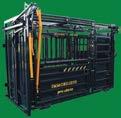

WOMEN IN AGRICULTURE pages 16-17
SPRING BULL SALE page 22
SOCIAL SCENE page 26
CLASSIFEDS pages 28-29
RECIPES page 30
MARKET ROUND-UP page 31
SPORT pages 29, 32
By Fiona Gowers
Key players give their thoughts on the alliance that is helping educate consumers on what constitutes Australian owned.
Todd Saunders, executive general manager of Sanitarium Health Food Company, which has been Australian owned since 1898 and is a trusted producer of some of Australia’s most iconic breakfast brands including Weet-Bix:
“Like our coalition partners, we don’t want there to be any confusion for consumers about the authenticity of Sanitarium’s Aussie ownership or the quality that endures within our product range,“ Mr Saunders said.
“We know how intrinsically proud Australians are of the great things that come from our country.
“This Includes ‘country of ownership’ labelling information and introducing better tools to support consumers in making an informed choice.
“This can help us continue to drive economic growth and provide job security for our employees and the regional farmers and suppliers who help us to feed the nation.
“By choosing the product of an Australian owned business such as Sanitarium or our coalition partners, customers are not just making a purchase, they’re making an investment in supporting local jobs and economies.“
Peta Allsopp, SPC chief marketing officer – one of Australia’s most iconic food brands that’s been part of the Australian grocery basket for 112 years - say that like their coalition counterparts, they are proud to remain 100pc Australian made and owned, but have certainly felt the impact of foreign competition in recent times.
“The current cost of living crisis is very real and, consequently, consumers are making very considered values-based choices. At times, they are either knowingly or unknowingly choosing imported options from lower cost producing countries such as China and South Africa.
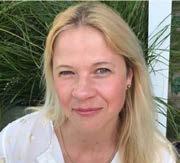

“Our ‘local first’ pledge is more than just a strategy; it’s our promise to support our local, Australian communities and, if enhanced labelling can help support this mission and better aid consumer choice, then that is something we fully stand behind.“
Chris Connors, Sunshine Sugar chief executive officer:

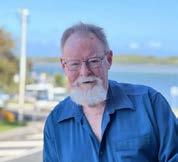
Address: 154-156 Haly Street Kingaroy 4610
Telephone: 07 4182 0450
Website: QueenslandFarmerToday.com.au
CONTACT US
Editorial:
Email: newsdesk@QueenslandFarmerToday. com.au
Advertising:
Email: advertising@QueenslandFarmerToday. com.au
Classifieds:
Phone: 07 4182 0450 or 1300 666 808
Email: sales@networkclassifieds.com.au
EDITORIAL
Fiona Gowers Editor
E: fiona.gowers@QueenslandFarmerToday. com.au
Breanna Lloyd Journalist
E: breanna.lloyd@QueenslandFarmerToday.com.au
ADVERTISING
Samantha Wantling Sales & Marketing
E: samantha.wantling@WarwickStanthorpetoday.com.au
P: 0439 420 289
Jane Lowe Sales & Marketing
E: jane.lowe@QueenslandFarmerToday.com.au
P: 0408 488 609
Jemma Wilson Sales & Marketing
E: jemma.wilson@BurnettToday.com.au
P: 07 4182 0458
Nicola Rickuss Sales & Marketing
E: nicola.rickuss@TodayNewsGroup.com.au
Queensland
“We are immensely proud of the quality of our SPC products and more committed than ever to delivering superior value to consumers, while working closely with our grower partners to innovative and become more competitive.
“So, if a small labelling update to include ‘country of ownership’ information can help better inform consumer choice, while protecting our iconic brands, industries and farmers alike, then that is something we fully support,” she says.
Bethaney George, Mayver’s Foods chief executive officer:
“With a mission to deliver high quality, 100pc natural, Australian-made products, Mayver’s Foods is proud family- owned and Australian made business, operating in categories saturated by foreign owned brands and imported products.
“Cost of living pressures are being felt far and wide, impacting all parts of the supply chain, which is why we have such a steadfast commitment to local sourcing and sustainability - by turning Australian ‘wonky fruit’ (otherwise destined to become food waste) into delicious jams, supporting Australian growers for our peanuts, almonds and local suppliers across our entire value chain.
Sunshine Sugar is a 100pc Australian sugar manufacturer, owned and operated in partnership with local sugarcane farmers.
“Sunshine Sugar is an incredibly proud brand in the Australian marketplace,” said Mr Connors.
“We are the only Australian owned refined sugar manufacturer and our business model is uniquely Australian.
“As somewhat the underdog in Australian sugar manufacturing, Sunshine Sugar is grown, made and owned in New South Wales. We aren’t as big as some of our overseas owned competitors, but have a strong customer base that highly regards our Australian roots and the consistent, reliable product quality and service we provide.
“Having our operations based in the regional communities of the NSW Northern Rivers, we see the struggle consumers face when trying to support Australian farmers and the research confirms that this struggle is occurring nation-wide.
“The concept of making clear the country of ownership - along with tools to help inform consumers seems like a step in the right direction –for Australian-owned businesses and our patriotic and supportive Australian consumer base.”
A Chinchilla man is ready to pamper his pooch after changing his regular numbers to include his dog’s birthday, fetching him a million-dollar win in Weekday Windfall.
The chirpy Queenslander held one of two division one winning entries nationally in Weekday Windfall draw 4445, drawn Friday 21 September 2024.
Each entry pocketed a clean $1 million.
The newly-minted millionaire shared he had been trying to fathom his newfound treasure for a couple of days since discovering the winning news late Friday night.
“Thank you so much!” he said.
“I’m thanking my dog because if I hadn’t changed my regular numbers to include his birthday, I wouldn’t have won. He’s already spoilt but he’ll be getting extra spoilt now!
“I checked my ticket Friday night and I was like ‘What? This can’t be right!’. I was up all night after that.
“My wife didn’t believe me, so she got a good sleep-in. When she finally realised I wasn’t joking, she actually threw up!
“The whole weekend I couldn’t take my mind off it. Now that it’s confirmed, I can finally let it sink in.
“It’s more than exciting. It’s phenomenal.”
When asked how he planned to use his million-dollar prize, the winning man had a few ideas in mind.
“We haven’t been on a holiday in years so that would be great to finally go somewhere and have a break,” he said.
“We can buy a house too. We’re renting so this is going to help so much.
“With the rest we can invest.
“Of course, once we’re less overwhelmed, we can go out to dinner to celebrate.”
Across Australia, there were two division one winning entries in Weekday Windfall draw 4445 – two in Queensland.
One of the most surprising facts I learnt as a journalism student at university was that the classified section is consistently the most well read in the newspaper.
And, particularly in rural and regional publications, there are certainly some gemstones sparkling in those “rivers of gold”.
Sadly, over the past five years, 166 news outlets have closed across Australia, 60 per cent of which are in regional and rural markets.
Local newspapers play a critical role in the fabric of small towns. They serve as a vital source of information, connection and community identity.
Originally from Condamine, Today News Group director Damian Morgan recognises this and, as such, is building a network of rural and regional publications through Queensland, Victoria, South Australia and the Northern Territory.
“A newspaper should hold the powerful to account while also providing a voice for the local communities we serve to advocate on important issues for our regions,” Mr Morgan said.
“In this era where false news spreads faster on social media than the truth does, it has never been more important to have a trusted and regulated source of news.
“We’re proud to be providing that service.”
As many small towns face the threat of newspaper closures, the importance of supporting these publications becomes clear.
Their survival is essential for maintaining informed, engaged communities.
By valuing and subscribing to local newspapers, residents not only preserve an essential resource but also invest in the future of their towns, ensuring that their stories, issues and voices are heard and represented.
- Fiona Gowers

By Fiona Gowers
Cost-of-living crisis aside, shoppers remain passionate about supporting Australian brands and hard-working farmers.
New research, however, has identified mass confusion in the market with an overwhelming number of shoppers inadvertently buying foreign-owned products in their attempt to buy “Aussie owned“.
This has prompted a coalition of food businesses to join forces to educate on what constitutes Australian owned.
Research from Norco shows a third (30pc) of shoppers have increased their support for Australian brands over the past two years, with many prepared to pay more if the money stays in Australia or returns to support hardworking farmers and their communities.
Australian Made vs Australian Owned
Despite the best intentions to support Aussie owned, the data revealed an overwhelming majority of shoppers (81pc) are actively buying foreign owned, with many simply relying on what they believe to be iconic Aussie brands.
Adding to the confusion, more than half of shoppers (56pc) simply look for the Australian made logo to inform their selection, with only one in 10 consumers doing their own research to make fully informed decisions.
Norco chief executive officer Michael Hampson said that while he was pleased with shopper support for Australian owned, it was disappointing to see the scale of confusion.
“What’s clear from the research, is that if we want to protect what’s left of our iconic and authentically Australian brands, there needs to be a greater conversation and further education around the difference between Australian made and Australian owned,” he says.
Under Australian Consumer Law, most foods produced, grown or made in Australia must display a label with the kangaroo triangle symbol or some statement indicating the food was produced, grown or made in Australia.
This, however, does not mean Australian owned.
Hampson adds: “While anything that drives jobs creation and economic activity in Australia is a good thing, it’s still important to know that many foreign-owned companies can still use this labelling.
“The big difference with ‘authentically Australian’ brands and products - those that are both Australian made and 100pc Australian owned - is that the money remains here in Australia and is not siphoned offshore.
“This means it can then be reinvested back into Australia and regional communities which, in turn, creates more jobs, can better support our hardworking farmers, while helping to sustain the industries in which they operate,” he says.
Iconic Aussie Brands Unite to Discuss Country of Ownership Labelling
Reinforcing shopper confusion, two thirds


(66pc) of Australians claim they would buy more Australian made and owned products if the information was readily available but claim it’s hard to tell, with nearly three quarters (73pc) believing “country of ownership“ information should be included on all food labels.
The notion has prompted bosses of major Australian food brands – including Norco, SPC, Sanitarium, Mayvers Foods and Sunshine Sugar - to join forces to explore the concept.

Michael Hampson believes it’s an interesting and worthwhile conversation to have.
“There is a clear desire among Aussie shoppers to support authentically Australian (Australian made and owned) brands and, as a 100pc Australian farmer-owned co-operative, this is extremely heartening to see.
“But the fact remains that many household brands we all grew up with are sadly no longer Australian owned, so clearer labelling could be beneficial in helping to combat this widespread
shopper confusion,” he says.
Following this, the coalition of “Aussie food bosses“ are urging consumers to arm themselves with knowledge and do their own research into which companies and products remain Australian owned.
As an easy first step, they’re encouraging consumers to download the Bring Back Australia App, which is uniquely designed to support and identify Australian-owned brands with a simple barcode scan.
$245






By Fiona Gowers
As cotton crops emerge from the ground in Queensland’s Central Highlands, growers are cautiously confident abot the impending season.
Emerald grower and Cotton Australia Board chair Nigel Burnett said with carryover from last season - and a welcome allocation from Fairbairn Dam - growers are positive.
“We had unseasonal rainfall in August and that enabled a good chunk of the area to be moisture planted, saving farmers from the initial flushup irrigation and those crops are now out of the ground and looking very good.
“Since planting, the conditions have been warming up and growers are confident about the prospects for the season at this stage.
“I have planted more than 700 hectares so far and if there’s more rainfall over the coming weeks and months, I would look at planting more cotton into late October, November or even December.”
Planting is underway across much of Australia’s cotton growing regions, with some crops already out of the ground in warmer climates. Some growers are holding back for warmer weather while some in tropical areas won’t be planting until rain begins to fall.
Cotton Australia general manager Michael Murray said the signs for this season were positive with Australia’s 1500 cotton growers - 90 per cent of them family farmers - expecting to generate around 4.4 million bales or one million tonnes of quality fibre. They are bound for export markets and a similar amount of cotton seed.
“This year we are expecting about 400,000 green hectares to be planted, predominantly in New South Wales and Queensland with crops also being planted in the Northern Territory and Western Australia,“ Mr Murray said.
“A result in line with expectations will see more than $3.1 billion generated for the national economy with most of that money filtering down into the 249 communities that benefit directly from cotton growing.”
Cotton planting usually occurs in early October in the core growing areas, but with a wide range of geographic areas now growing cotton, planting dates are widespread.
The global outlook for cotton is stable with a recent uptick in cotton futures attributed to potential damage to the US crop due to storms and heavy rain and a surprise reduction to US production forecasts.
“Despite the global situation we are still selling our cotton to a market wanting high quality product and we are experiencing good buyer support from across Asia including China,” Mr Murray said. “Our growers remain positive on this season’s crop with good conditions including soil profiles, moisture content and water allocations and, for most, the current price still reflects a profitable outcome with all its flow-on benefits.”
Cotton Australia’s regional managers, based in each of the cotton growing regions, have provided up to date reports on each region:
Central Highlands:
Cotton planting has been underway for several

weeks with cotton already out of the ground in some areas with some growers already undertaking first irrigations. The cotton is looking healthy, pleasing growers, with plant stand looking strong. The planting conditions were so good, as many got to plant on rain and it’s been so warm that plants were coming out of the ground within days.
Around 20,000 hectares of irrigated cotton is expected, with around 4000 hectares of dryland.
Ginning will continue through to November, with some cotton still being carted into the gin from northern QLD growers.
Dawson and Callide Valleys
Some growers have started planting the expected 8500 hectares of irrigated cotton, with some al-
ready finished planting, while others planted in October. Dryland growers are expected to plant in November. There has been a good start to planting, with full allocations helping growers with a positive start to the cotton season.
Darling Downs
One grower has already planted 400 hectares of cotton for this coming season with 30,000 hectares of irrigated and 5000 hectares of dryland expected. Some recent rain has been welcomed but the weather is cooler so most growers will hold off planting until warmer temperatures in October.
Macintyre Valley
In the Macintyre, growers will be looking to start
planting when soil temperatures increase. Growers are expected to plant about 20,000 hectares irrigated and 8000 hectares dryland. There has been recent rainfall but this won’t affect cotton plants at the moment.
St George/Dirranbandi/Mungindi
Conditions have been unusual, with below average temperatures. In St George one grower has already planted 350 hectares of cotton with the majority expected to begin planting by 7 October.
In St George, 22,000ha of cotton is expected to be grown, with 15,000ha in Dirranbandi and 18,000ha in Mungindi.


By Breanna Lloyd
Central Highlands Brangus producer of 25 years has made history at the 48th annual National Brangus Sale after equalling the top-priced record of $150,000 and selling two bulls for a quarter of a million dollars.
Held on Tuesday, 15 October at CQLX Saleyards, Gracemere, the sale saw 240 lots of red and black registered bulls and 17 herd bulls.
The overall sale sold 197 bulls with a clearance rate of 82 per cent, gross of $2.643 million and averaged $13,416.
These results left last year’s figures in the dust after the 2023 top-priced bull sold for $70,000 with a clearance rate of 86 per cent and an average of $13,096.
Within the first five minutes of the sale, Mick Madden of Earlwood Brangus, Duringa, was blown away by the result of his first bull, Earlwood Haas, lot 75, sold for $90,000 and Earlwood Cobbo, lot 76, the second top-priced bull of the sale, which sold for $120,000 to Lindsay and Fiona Barlow, Triple B Brangus, Dingo.
Earlwood Cobbo is a 24-month-old black polled bull weighed 920kg, with a 41cm scrotum.
By the time Earlwood Riki, lot 79, strutted into the sale ring, Mr Madden couldn’t believe what was unfolding in front of him.
Earlwood Riki, a 24-month-old polled black bull weighing 842kg, sired by Tannyfoil P79 and out of Earlwood 3949, sold for $150,000, topping the sale, purchased by Triple B Brangus.
This being Mr Madden’s first time topping a sale and achieving over $100,000, he said it is an extremely overwhelming feeling.
“Going into the sale I knew the bulls would do well, I just didn’t think they would make that kind of money and top the sale,” he said.
“I have worked all of my life for a result like this and it shows that all of my hard work has finally paid off.
“This wasn’t something I was expecting at all.
“It didn’t hit me until I walked out the back and thought…what happened there.”
Mr Madden’s Earlwood Riki now holds the Australian Brangus top-priced bull record along with the 2022 record-breaker Telpara Hills Mach Five 920R4, offered by the Pearce family of Telpara Hills Brangus and Ultrablacks, Barron.
Mr Barlow told reporters they were determined to purchase Earlwood genetics, having missed an opportunity to buy the sire Tannyfoil P79 many years ago.
“You can spend a lot of money in a number of minutes and I believe these bulls were worth it,” he said.
“Earlwood had what we were looking for and unfortunately we had to break the budget to secure them.
“We were the losing bidders of the grandfather many years ago, we tried to buy the sire of these bulls but we were outdone.”
Mr Madden sold all five of his bulls for a total of $470,000 with an average price of $83,000.
Elders Rockhampton agent Randall Spann said what a way to start the sale.
“You couldn’t script it any better, overall it was an amazing sale and thanks to its terrific start that strong pricing was carried right through,” he said.
“There were a couple of places where the pricing got a bit softer but all in all it was good right throughout the catalogue.”
Brangus Australia chief executive officer Nathan Sullivan shared how the sale saw an increase on average by nearly $400 compared to last year.
“It is a hell of a result for Earlwood Brangus,” he said.
“I’m positive that Earlwood Riki is the highest bull sold at CQLX or Queensland this year, so it’s a fantastic result for the Brangus breed.
“Congratulations to everyone on such a successful sale.”
By Breanna Lloyd
This year’s lineup at the National Brangus Female Sale on Monday 14 October, left commercial and stud vendors impressed after receiving 100 and 87 per cent clearance.
Auctioned by Ray White Livestock Rockhampton, GDL, Elders and Stocklive at the CQLX Saleyards, the sale saw 213 lots of red and black commercial heifers, cows and calves and 52 lots of stud females.
The commercial females averaged $1141 with 100 per cent clearance, a $243,150 gross and a top price of $2500 per head for lot 48 offered by BN and LJ Woodard to LR and HA Woodard of Gracemere.
The stud females saw a top price of $22,000 for Stutzview Unforgettable, lot 28, offered by Stutzview Brangus Stud to Sowden Cattle of Booie.
The 13-month-old female is sired by Triple B Revolver and damed by Stutzview 746.
The average price for the stud females was $6577 and had a clearance rate of 97 per cent
after selling 45 out of 52 offered.
Compared to last year’s sale, the stud females sold 43 registered females for a top of $45,000, and an average of $10,395.
The embryo genetics package sold for $1000 and the semen genetics package sold four out of five with an average of $70 per unit, the top price being $160 per unit.
Vendors and buyers travelled from across the state, New South Wales and Victoria to attend the sale. Brangus Australia chief executive officer Nathan Sullivan said overall it was a successful sale.
“Compared to last year’s results there was a similar clearance rate with the stud females and an increase on the average by $300, so I think the vendors will be happy with that,” he said.
“Thank you to the Sowden family who have shown strong support at this year’s sale as they are just starting to get into the Brangus breed from Kingaroy.
“It was a great day for all commercial heifers as well and when you consider the current market, they sold well.”
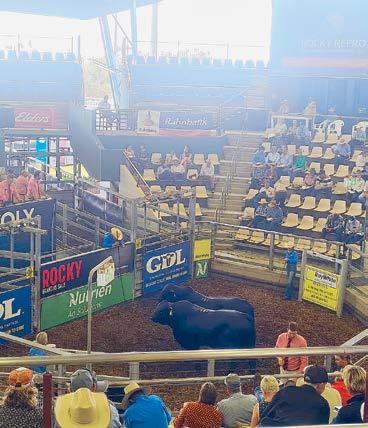




The steaks were high at the seventh Toowoomba and Surat Basin Enterprises (TSBE) Darling Downs Beef Battle.
Nine of the region’s best beef brands - Australian Country Choice, Grove Shorthorns, JBS, John Dee, Mort & Co, NH Foods, Rangers Valley, Stanbroke and Stockyard - showcased their brand and superb product to more than 500 attendees. Darling Downs Beef Battle sees two categories awarded: The Darling Downs Beef Battle Professional Choice, scrutinised by a professional judging panel and Darling Downs Beef Battle People’s Choice, which was decided by 500 beef fanatics!
This year, Stockyard won the 2024 Darling Downs Beef Battle Professional Choice with Kiwami wagyu, while Stanbroke won the 2024 Darling Downs Beef Battle People’s Choice with Diamantina wagyu.
TSBE Food Leaders Australia general manager Rowena Beveridge says the competition is a fantastic celebration of Darling Downs Beef and a wonderful opportunity for industry to gather and acknowledge our leading grain-fed brands.
“We are so proud to be able to host this event, recognising some of the world-class producers in our region. More Darling Downs steak should be on plates across the country and around the world.”
The Darling Downs is home to Australia’s best steak, with the region being responsible for producing 65 per cent of grain-fed beef consumed in Australia.
Darling Downs Beef Battle is all about spotlighting the industry and providing an opportunity unite, enjoy and recognise world-class product.
The Darling Downs cattle production and meat processing sector is critical to our region’s economy, worth more than $1 billion annually.
Again in 2024, the task of cooking 540 kilograms of premium sirloin was overseen by grill master Samuel Burke, Meat and Livestock Australia business manager and corporate executive chef.



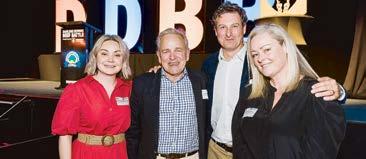

Leather Cattle Co, a grassfed and EU certified humane cattle enterprise from central Queensland, has been awarded the Success Through Collaboration award at the Global Conference on Sustainable Beef in Punta del Este, Uruguay.
The Success Through Collaboration Award is given to the business that best exemplifies the foundational principles and goals of Global Roundtable for Sustainable Beef and drives collaborative efforts to advance beef sustainability.
For Melinee and Rob Leather, who own and operate Leather Cattle Co, evidence of the relationship between environmental health and the prosperity of grazing enterprises drives them to prioritise and invest in sustainability across their beef business.
Leading by example, Leather Cattle Co implements positive change by building extension and adoption networks throughout their community in order to enhance, strengthen and protect not only their business but build the capacity of their broader industry.
With strong links to industry, producer and community networks, the reach and exposure of outcomes are shared through media and presentation opportunities.
“What really brought our local community together was realising that we are a like-minded group of producers who wanted to have a focus around sustainability,“ Ms Leather said.
“We could see that sustainability for the beef industry was going to be something that was going to be critical for us going forward.
“We were starting to see some really significant changes with the climate, we felt like we were getting hotter and drier as our community had been through some pretty prolonged droughts here in Queensland.
“So, producers really wanted to get together and have a platform where they could share learnings, share information around technology.“

ing climate change.
“Beef producers manage more than 50 per cent of Australia’s land mass, so we have got a huge responsibility to make sure that we are managing it collaboratively and sustainably,” Ms Leather said.
look to in order to define our sustainability goals and actions.”
Global Roundtable for Sustainable Beef president Bob Lowe spoke of Melanie Leather and Leather Cattle Co at the Global Conference on Sustainable Beef awards on October 2.
building extension and adoption networks to enhance, strengthen and protect not only their business but build the capacity of their broader industry,” Mr Lowe said.
All of the works they do on their properties showcase the Leather’s belief that productive cattle enterprises can go hand in hand with address-
“It is an absolute privilege to be recognised with this award. It is organisations like the [Global Roundtable for Sustainable Beef] GRSB that we
“Leading by example, Melinee Leather, Leather Cattle Co, strives to implement positive change by






“Melinee and Leather Cattle Co have received this global award as they have demonstrated practical steps towards achievement of the GRSB’s goals.”











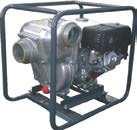












By Breanna Lloyd
More than 160 Braford bulls and three heifers from across Queensland and New South Wales went under the hammer for the National Braford sale at Gracemere, CQLX Saleyards on Monday 9 September.
The top-priced bull and new top record for MCN Brafords of The Glen, Western Downs, went to MCN Iceman (lot 45) who topped the sale at $45,000 to the Kenny family of Harriett Valley Brafords.
The McNamara partnership sold all nine of their bulls, averaging $22,779, including MCN Wolfman, who was the grand champion Braford bull at BEEF2024, for $36,000 to Brian and Trinkett Anderson, Theodore and MCN Wolfman for $36,000 to Daniel and Alicia Sampson, Winton.
Amy and Tim McNamara of MCN Brafords thanked all buyers, under-bidders and their auc-
tioneer GDL agent Mark Duthie.
“We are blown away by this incredible result,” she said.
“While the sale results are fantastic, it is wonderful to see they went to great homes.
“All of our bulls have gone to excellent homes and fantastic mobs of cows and we look forward to seeing their progeny.”
The McNamara partnership is glad to have grabbed their bidding cards, after purchasing Carinya Calcino, lot 150, for $16,000 from JH and BJ Amor, Carinya Brafords, Dulacca.
“We have always admired Carinya’s cattle for their ability to do so, soft skin and a good skin type, strong sires, and lengthy and good depth appeal,” she said.
“We work our cattle based on commercial conditions.
“Although we keep good content in our fe-
males for their functionally on our Coolibah Ridge country, we try our best to bring in sires that keep our weight for age as good as any.”
The McNamara partnership, Don and Majella, Holmwood, Tim and Amy, The Glen and Longacre and Mark and Tara, Kooinda, has commercially bred Brafords for over 50 years.
While it was a successful sale, Amy said the seasonal results had left their country calling for rainfall.
“This is why we breed Brafords because of their adaptability to the numerous seasonal environments, especially in Coolibah country,” she said.
“Brafords meet all of the markets and you can really take them anywhere and they will do well.”
Although this year’s seasons haven’t been in favour of agricultural producers, the national sale proved otherwise, after having an 89 per cent total clearance rate (145 lots out of 162).
The Braford bulls averaged $10,806 while the heifers received a 100 per cent clearance rate, with the top price of $7000 and averaged $5333.
Compared to the previous year, the sale clearance sat at 92 per cent and the top-priced bull went for $32,000 with a $9476 average sale price.
Australian Braford Society president Stuart Dingle said producers were struggling prior to the rainfall that hit the Central Highlands.
“Now we have had rain around the area, the slight jump in the prices has given everyone a bit more hope back in the industry,” he said.
“The market for the bulls is starting to reflect on that now.”
The national sale being the highlight on their calendar, Amy and Tim said they hope to have nearly 15 bulls in next year’s national sale.
“We aim to continue growing our business and producing quality Brafords each year,” Amy said.

More Santa Gertrudis bulls offered for sale this season will be working the paddocks of Australian beef operations thanks to the preference of astute cattlemen to invest strongly in proven genetics that will boost their herds and bottom lines.
With seasonal and market conditions at an uncertain phase in the cycle, beef producers have shown through their buying patterns at Santa Gertrudis stud sales this season that they want low-maintenance, low-input cattle, that can thrive in a range of environments and slot into different markets when opportunities arise.
Out of the 32 stud Santa Gertrudis sales held in NSW and Queensland only from August to October, 93 per cent of the bulls offered sold to buyers at an average of $11,620, a six per cent lift on last year’s clearance and a $1463 increase on last year’s sale average.
Other Santa Gertrudis stud highlights from this season include:
• Highest sale average: $17,586, Murgona stud, Taroom followed by $16,575, Santahat, Monto.
• Highest clearance: Studs that cleared 100 per cent of their catalogues under the hammer: Bullamakinka, Longreach; Nioa/RL, Allora; Murgona, Taroom; Santahat, Monto; Yarrawonga, Wallumbilla; Waco, Mungallala; Jamar, Comet and Strathmore, Blackall.
• Highest price: $115,000, Canowindra stud, Emerald followed by $110,000, Waco stud, Mungallala, and $85,000, Yarrawonga stud, Wallumbilla.
Santa Gertrudis Australia general manager Brad Cooper said production costs and tightening margins meant buyers were eschewing “fashions and fads” in preference for cattle that have decades of history delivering for the producer and their supply chain partners.
“Beef producers are no different to all business owners and managers – they want a product that is efficient to produce and is in demand by the customer who is willing to invest in quality because they have confidence in the return,” Mr Cooper said.

“From what I’ve observed at sales this Spring, we’re seeing a “back to basics” mindset, focused on reliable, durable and highly productive animals that will turn out quality for the end-consumer and generate profitability across the chain consistently.
“Prices beyond the stud ring to the commercial arena also bear this out, where significantly higher cents per kilo are regularly being paid, whether by restockers, lot feeders or processors, for Santa Gertrudis and Santa infused cattle
across most descriptions.”
Mr Cooper cited data published in September from the online livestock auction interface, AuctionsPlus, showing Santa Gertrudis cattle topped the clearance rate chart at 89 per cent out of all cattle breeds listed on the platform in 2024.
The Santa Gertrudis breed also recorded the highest average price per head at $1498, with the price over reserve averaging 15.36 per cent above set reserve rates, indicating “strong competition for Santa articles”, according to the
report’s author.
Santa Gertrudis cattle this year also recorded the highest value over reserve (VOR) at $286, an average of 15.4 per cent above set reserves and $64 higher than the Hereford breed in second place, illustrating the higher premium potential in Santa Gertrudis when presented to buyers over the past nine months.
“Buyers have emphatically told the market this year that if you want the beef job done right, you buy Santa Gertrudis,” Mr Cooper said.

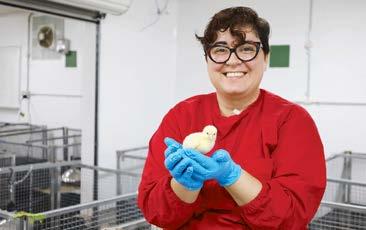
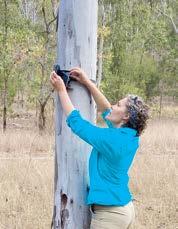
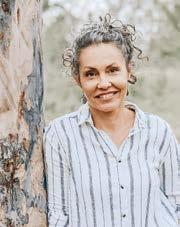
On the farm or in the field, studying science with CQUniversity is a proven formula for building a big career around your passion.
For former cafe owner and craftswoman Maria Whitton, her love of learning led to funded research to improve primary producer processes.
Taking on CQUniversity’s Bachelor of Agriculture in 2018, the Rockhampton student got handson experience in growing trials – and never looked back.
“This newfound interest led to projects like growingmushroomsandworkingonblacksesame trials with the team at CQU’s Central Queensland Innovation and Research Precinct (CQIRP),” Maria said.
“The turning point came in 2019 during a CQIRP industry placement when I was involved in poultry research (and) I found that I was not only
interested in it, but also good at it.
“I had so much fun doing laboratory work that I stayed more hours than were even needed for the placement.”
CQU’s Bachelor of Agriculture equips students with industry-relevant training, experience and problem-solving skills, to drive improved productivity and sustainability of modern agriculture.
Available for flexible study online, and on-campus in Rockhampton, Bundaberg and Emerald, the three-year degree prepares graduates to make a difference in Australian agriculture – set to grow to a $100 billion industry by 2030.
Thanks to an Elevate scholarship, funded by CQU industry partners, Maria now has a funding to complete PhD research.
“I relish the camaraderie and the opportunity
to engage with diverse projects… I’m eager to see where it takes me,” she said.
For businesswoman and mum Misty Neilson, her career in environmental science was decades in the making.
A passionate environmentalist in high school, she began her Bachelor of Science and Environment with CQUniversity aged 35.
“I had three kids and I worked, and CQU’s flexible degree was the only way I was ever going to be able to study – I couldn’t die without doing it,” she said.
During her studies, Misty began new roles in environmental science, co-founded her environmental and community consultancy Thriive, and supported CQU research projects.
Graduating in 2021, the North Burnett innova-
tor continues to inspire and connect her community with citizen science.
This year she was named CQU’s Alumnus of the Year for Early Career Achievement, following her projects to protect local koala and greater glider populations.
Her groundbreaking work included mapping habitat, and DNA testing scats to understand genetic diversity and health.
“What I love about citizen science, is that people, community, they hold a wealth of information – and their interest in learning and being a part of something is immense!” she said.
“Citizen science can cover more ground than you ever would as a research scientist – and CQU has given me incredible experience, and an amazing platform to make these projects happen.”

Australia’s most promising young dairy cattle judges delivered an impressive display of skills and expertise last month at the 2024 National Dairy Cattle Young Judges Championship, held at the Melbourne Royal Show.
Emerging victorious was 19-year-old Patrick English from Malanda, Queensland, who has now positioned himself as one of Australia’s top talents in the agricultural sector.
This prestigious competition, organised by Agricultural Shows Australia (ASA), brought together elite judges aged 17 to 25 from across the country, all of whom qualified through competitive regional and state events.
Patrick, whose family has exhibited Illawarra cows at their local show for 108 consecutive years, was honoured to win against a talented field of competitors.
“I have lived all my life on a dairy farm and winning this championship is a dream come true,“ said Patrick. “It’s an incredible opportunity to represent my community and the hard work of my family.“
Patrick’s competitive judging path has been marked by a number of notable achievements, including a recent victory in the State Young Judges Finals held at his local show in 2023, qualifying him for this year’s national competition.
The dairy cattle young judges competition assesses who most accurately places the animals from first to fourth, according to its form and characteristics and justifies their assessment.
Competing alongside Patrick were five other state champions, all demonstrating excellent analytical and communication skills, as well as
an evident passion for the dairy industry.
In second place was Angus Fraser from Tongala, Victoria, who had qualified for the second year in a row to represent Victoria at the national finals.
Third place went to 25-year-old Bridget Liebelt from Meadows, South Australia, who runs her own stud, Torlea Holsteins & Ayrshires.
Agricultural Shows Australia executive officer Katie Stanley congratulated Patrick on his achievement:
“The National Dairy Cattle Young Judges Championship is a keenly contested event and Patrick should be proud of the hard work and dedication it took to reach this prestigious level.
“These young judges are the future leaders of agricultural show competitions and, the young judging competitions, offer a unique opportunity for them to grow personally and professionally.
“I have no doubt that the crop of young judges we have seen here today will play a crucial role in advancing Australia’s livestock industries.“
The competition is part of ASA’s national competition program, which includes nine categories ranging from beef cattle to poultry and Merino fleece judging.
Patrick English of Malanda in Queensland is one Australia’s most promising young dairy cattle judges. (Supplied)



By Fiona Gowers
The nation’s top young judges across Merino fleece, meat breeds and Merino sheep have been announced at the 2024 Melbourne Royal Show as part of the Agricultural Shows Australia (ASA) Young Judges and Paraders National Championship.
The National ASA Young Judges and Paraders Championships celebrates the best young talent aged 15 to 25 from each state. Following success in the regional and state competitions, entrants participate in the National Championship to vie for top honours.
This year, Queenslander Grace Hillier, 23, of St George was runner-up in the ASA Merino Fleece Young Judge competition, while Hannah Haupt, 21, from Sheldon placed second in the Meat Breeds Sheep Young Judges competition.
Meanwhile, West Australian Brendan Lamont of Tambellup claimed first place in the ASA Merino Fleece Young Judge.
The competition’s youngest competitor Christine Sutton from Cobbitty, NSW was awarded ASA Meat Breeds Sheep Young Judge winner and Bateson Pittman from Walcha, NSW won the ASA Merino Sheep Young Judge.
Judging involves competitors visually assessing livestock by comparing animals against each other and explaining their decision and, for fleece, identifying traits with high commercial value.
The competition involves skills in communication, public speaking and breed-specific knowledge.
Agricultural Shows Australia chairman Dr Rob Wilson praised the work of the young judges and their valuable contribution to the agricultural sector.
“The young judges play an important role in the future of Australian agriculture by identifying the best traits that will contribute to breeding the next generation of quality livestock,” Dr Wilson said.

“Congratulations to Brendan, Christine and Bateson on their judging prowess. It is a proud achievement and wonderful to see such a high calibre of young, enthusiastic competitors coming through the ranks.
“The future of agriculture is in good hands.”
MERINO FLEECE
Queenslander Grace Hillier, 23, from St George has placed second in the ASA Merino Fleece Young Judge competition.
Grace has been involved in her family sheep stud since childhood and has travelled to shows around Queensland.
Competing in Junior Judges and drawing on what she has learned from various judges, Grace used her experience to aid her decision-making in fleece and sheep competitions.
Brendan Lamont, 23, from Kojonup, WA won the ASA Merino Fleece Young Judge competition.
Growing up on a family farm with a fine wool Merino flock and now running his own Ile de


France stud, Brendan brings first-hand experience to the competition, but was completely surprised with his win.
“I didn’t think I had a chance, it was a bit of a shock,” Brendan said.
“I was looking for sound fleece with high commercial value and it was a strong, viable round overall.
“Credit must go to all the competitors who made the competition worthwhile.”
For young people interested in judging, Brendan emphasised, “Listen to your teachers and get involved in industry programs.
“It’s good to be on-farm and learn on the job, but it’s equally important to gain knowledge and experience across all aspects of the supply chain.”
Reflecting on the challenges facing the WA sheep industry, he added: “It’s tough going for the sheep industry in WA right now, but we need more young people to get involved.
“The judging competition is a great learning opportunity.”
MEAT BREEDS
Hannah Haupt, 21, from Sheldon in Queensland has placed second in the Meat Breeds Sheep Young Judges competition.
Hannah’s journey into sheep showing began in 2015 when she joined her high school’s livestock show team in year seven.
Having grown up in Brisbane, this was her first experience with agriculture and she has honed her judging skills ever since, leading her to win the Queensland state finals in 2023.
Hannah, who has a degree in microbiology, says she enjoys working with sheep and learning about the industry.
“For example, why we judge sheep and why we want to breed for specific traits and how that benefits producers,“ she said.
“I’ve enjoyed judging competitively for a while and, because I am doing well at it, I’ve also become an associate judge in Queensland.
“I’ve gained a lot of confidence through judg-
ing, especially with public speaking.
“Also, to be able to justify my decisions while speaking is an important skill I’ve learned. And, also, just how important the sheep and agricultural industries are.“
Christine Sutton, 15, from Cobbitty, NSW was sashed winner of the ASA Meat Breeds Sheep Young Judge competition, an achievement made all the more impressive as this was her first time participating in the competition.
“This is my first year entering and I’m only 15,” Christine explained. “I had hoped to win at the state qualifier, but winning the nationals was a big shock, I wasn’t expecting to win.”
Christine’s family breeds Border Leicester sheep and she’s had a keen interest in the industry since her early days - she even attended the Canberra Royal when she was two weeks old.
“I started judging at school and I’m now a senior student helping to get younger students involved. I want to continue my judging experience and next year hope to qualify for the Merino sheep finals.”
Christine is eager to encourage other young people into judging.
“It’s such a great event with lots of opportunities.
“Don’t be scared, just get involved, you never know where you’ll end up.”
MERINO FLEECE
1. Western Australia - Brendan Lamont, Tambellup
2. Queensland - Grace Hillier, St George
3. Tasmania - Cally Spangler, Bagdad MEAT BREEDS
1. New South Wales - Christine Sutton, Cobbitty
2. Queensland - Hannah Haupt, Sheldon
3. South Australia - Elsie Johnson, Peake
MERINO SHEEP
1. New South Wales - Bateson Pittman, Walcha. 2. Tasmania - Ashley Meaburn, Runnymede.
3. Victoria - Kasey Shields, Kolara.


By Fiona Gowers
Olivia Delaforce from Mt Beppo in Queensland was last month crowned champion young beef parader at the Melbourne Royal Show.
Mitchell Taylor from NSW, meanwhile, claimed champion young beef judge.
Olivia, 21, helps run her family’s Santa Gertrudis stud and also works for a large-scale Speckle Park stud in Oberon, NSW.
Parading cattle since she was around eight, Olivia’s experience and passion for the industry shone through her performance.
She was also crowned runner-up in the grains young judging competition.
Olilvia says she enjoys the friendships, competitive rivalry and learning new ways to show off cattle.
“Winning the 2023 Royal Brisbane Show State Finals has allowed me this incredible opportunity to compete at nationals,“ she says.
“Being around cattle and, more importantly, complying with cattle has taught me, patience, resilience, strength and even though there is always one winner, teamwork and the importance of good friends and the show community helps you get to the top.“
Olivia hopes to build a career in a rural industry. Although unsure of the direction, she is keen
to continue judging and parading and teaching children the benefits of these agricultural events.
“I also enjoy the aspect of breeding beef cattle , like good genetics, good food, good environment and good temperament so a career along those lines would be cool too!“
The Beef Paraders and Young Judges Championships brings together the best young paraders and judges, aged 15 to 25, from each state to compete at the national finals.
Qualification is through success in competitive regional and state competitions.
Agricultural Shows Australia (ASA) executive officer Katie Stanley, expressed immense pride in the calibre of young paraders and judges that were on display.
“This prestigious competition showcased finalists who not only possess immense talent, but whose evident passion and dedication for the agricultural industry is truly admirable,“ she said.
“These young people are the future of agricultural show competitions and future industry leaders who have made themselves, their families and their communities very proud.“
Champions Olivia Delaforce and Mitchell Taylor now join a prestigious list of young paraders and judges who have proven their abilities on the national stage.
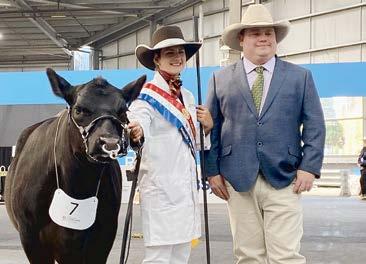




By Breanna Lloyd
Buyers at the Central Brangus Classic saved ‘the best for last’ after a bidding war erupted over the last bull on offer, lot 136 on Friday 27 September at CQLX Gracemere.
Bullrush Gordon, offered by Mark and Pauline Lloyd, Bullrush Pastoral, Nebo, sold for $34,000 to Linda and Lou Geddes, LA Geddes Co, Stanage Bay.
The 35-month-old polled Brangus bull, sired and dammed by Bonox and Bullrush Pastoral blood, weighs 938kg and has a scrotal size of 40cm.
Mark and Pauline said they were extremely overwhelmed by the incredible result.
“We couldn’t be more humbled that purchasers were willing to pay so much for our cattle,” Mr Lloyd said.
“This is something we were not expecting, especially to top the sale with a herd bull, we are considering this as a once-in-a-lifetime opportunity.
“We are very proud of how the bulls behaved throughout the selling process as well.”
Out of the 120 Brangus bulls offered, 115 were sold leaving it to a 96 per cent clearance rate, with an average of $10,008.70.
The females received a 100 per cent clearance rate of the 14 offered, with an average selling price of $4571.43.
The top-priced female, Bonox B1592, is a registered heifer from Bonox Brangus, BN and LJ Woodard, sold for $7000 to TJ Kuskey.
Bullrush General, a 34-month-old polled herd bull, sold for $22,000 to WJ and MF Maguire and their third bull, Bullrush Granville, a 35-monthold scurred herd bull, was sold to Jason and Maria Lloyd of Beeblee Brangus for $16,000.
Purchasers of Bullrush Gordon Lawson and Bonni Geddes said we bought the best bull in the sale.
“You never know what to expect when coming

into a sale, but it was pleasing to see a solid result and high clearance rate,” Mr Geddes said.
This being their highest achievement at a sale yet, the Lloyd family are excited for what the future holds.
“All vendors are terrific cattlemen/women and we thank them for their devoted support,” Mrs Lloyd said.
“The entire sale process is always well organised and everyone involved should be proud of themselves.
“We look forward to next year’s sale will hold.”
Mr and Mrs Lloyd have bred commercial cattle for over 40 years, and have since built their Bran-
gus herd off Texas Angus and Couti-Outi genetics.
Located between Nebo and Moranbah, the Lloyd family focuses on breeding quality cattle, with strong sires, straight backs, tidy underlines, length, depth, good temperament and strong fertility.
Bullrush Brangus had another reason to celebrate on Friday, after purchasing the second toppriced bull for $27,000 offered by LA Geddes Co., auctioned by Julian Laver.
Couti-Outi Cabrillo 1253, lot 29, is a 35-monthold registered bull, weighing 925kg with a 43.5cm scrotal.
His sires and dams follow back to Palgrove and
Couti-Outi bloodlines.
The Geddes family sold six of seven bulls with an average price of $14,333.
Mr and Mrs Geddes were extremely happy with the sales results.
“We are glad our animals went to new and returning clients,” Mr Geddes said.
“Many cattlemen who attend the sale each year always meet my bull requirements.
“We would like to thank all vendors for the sale and the fantastic job they did, especially for John Collins for his amazing work putting the sale together and to Nutrien Livestock for their tireless work and preparation for the sale and bull walk.”



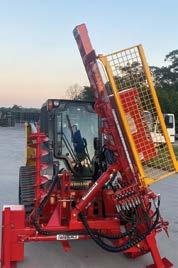


One of Queensland’s largest organic beef producers says education is the key to women thriving in the ag space, acknowledging last month’s 2024 International Day of Rural Women.
Held on 15 October each year, the United Nations Initiative promotes the role women play as food providers and protectors of the environment, calling for more opportunities for women in agriculture as producers and decision-makers.
It’s a message close to the hearts of Anna Appleton and her husband Fred, who, in conjunction with Loid and Zabby Appleton, operate Appleton Cattle Company, producing organic beef from 11 properties covering more than 2.2 million hectares.
Both were finalists in the 2024 Australian Organic Awards, Anna as Organic Woman of the Year and Fred as Organic Farmer of the Year.
Anna Appleton grew up on a cattle property at Clermont in Central Queensland and married Fred, a commercial helicopter pilot.
In 2005 they teamed up with Fred’s brother and parents to form Appleton Cattle Company and bought their first property.
Acknowledging the International Day of Rural Women, Anna said she had been fortunate to “grow with the business” and learn along the way.
“When my fourth daughter was six-monthsold, I enrolled to study a Bachelor of Business degree externally and, although it came with many challenges, it has really helped me in the long term as I work in the administration and finance side of the business,” she said.
“But, I’ve also learned so much from networking in the rural communities we live in and visit and through constant conversations with other people who share their lived experiences.”
The Appletons were aware of organic practices, however made the decision to convert to full organic beef production and gain accreditation more than 10 years ago, which Anna said was “a big turning point”.
“We were already fairly organic in our practices, so it was quite an easy transition, but moving to certified organic production has been pivotal to the growth and profitability of Appleton Cattle Co,” she said.
“Education has been a very important factor in our organic journey – I feel you’re never too old to learn and adapt.
“The ag space is changing rapidly with the focus on sustainability, monitoring and reporting factors like ESG and carbon, so we need to be

open to learning about and understanding these requirements.
“A fast, reliable internet connection is also paramount to operating our business. I’m currently between Birdsville (1600km west of Brisbane) and Bedourie and we rely on both NBN and Starlink satellite technology, both in the office and the paddock.
“Starlink has given us a reliable and affordable option for connectivity in the station camps, for the station hands or for individuals when they’re working alone and remotely.”
Anna estimated a 10-fold increase in the number of women working in the pastoral beef industry and said the company often had more female applications than male for jobs in stock
camps and on stations.
Whether male or female, Appleton Cattle Company is diligent about mentoring their employees and offering guidance on a broad range of issues including financial literacy.
“It’s not always formal but it is one of the things we’ve always done,” she said.
“We can’t do what we do without our people, so we try to ensure that everyone in the workplace is invested in the same journey as us, that they understand why we do what we do and have a good grasp of how to comply with all the different organic and animal welfare programs.
“We are always happy to share knowledge and skills, in the hope that it will assist our employees in both their working and personal life.”
As a mother of four daughters, Anna feels positive for their future and for the rural women of their generation.
She acknowledges that women have come to the fore at pivotal moments for the industry, such as the millennium drought and the ban on live cattle exports to Indonesia and has enjoyed seeing them highlighted in magazines such as Graziher.
“I think we’ve come a long way in the rural and agricultural industries. Today women play a big role in their partnerships and they embrace it all.
“The women of my generation - and my daughters - are in a good position and I feel very fortunate to work with and learn from so many different and inspiring women.”
An award-winning global agri-food industries leader has been appointed the new independent chair of Ag Shows Australia (ASA).
Jacqueline Wilson-Smith from the Sunshine Coast replaces retiring chair Dr Rob Wilson AM who has guided the ASA since its inception in 2016.
Ms Wilson-Smith brings extensive experience over 30 years across a range of agri-food industries and membership-based organisations including Fortune 500 company McCormick and Company Inc, Kraft Foods and Gourmet Garden.
She has held senior international executive roles in strategic marketing, branding, product promotion, market development, design thinking, R&D, innovation, commercialisation and stakeholder engagement.
She is currently director of a range of organisations including Meat & Livestock Australia, Apples & Pears Australia and the Sustainable Innovation Company, as well as chair of the AgriFutures Ginger Research Advisory Panel.
Ms Wilson-Smith said she was delighted to have been appointed to the role and paid tribute to the outstanding achievements and advocacy of retiring chair Dr Wilson.
“He leaves an incredible legacy,“ she said. “During his tenure he was instrumental in obtaining almost $100 million in federal Government funding including grants and covid funding.
“This funding proved vital to financially sustaining more than 580 agricultural show societies and royal shows, which could not operate during the pandemic years,’’ she said.
“For more than 200 years, agricultural shows have brought people together across the nation with one in six people attending a show each year and this funding was critical in ensuring this remarkable legacy continued.”
Ms Wilson-Smith said Dr Wilson had strongly advocated the important role the agricultural show movement plays in the nation’s social and cultural heritage while generating $965 million for the economy annually.
“We are most grateful for Rob’s incredible efforts in bringing the show societies together to form the one unified body representing their interests eight years ago.’’
Ms Wilson-Smith said she was passionate about AgShows offering a powerful platform to unite communities, welcome new Australians and present opportunities in agriculture.
“I believe the show movement is something every Australian should be proud of, providing valuable connection points such as town to country, farm to plate and insight in rural life,’’ she said.
ASA represents more than 580 shows nationwide and works to engage, influence and promote the essential value of Australian agriculture.

By Fiona Gowers
The famous phrase: “Find a job you love and you will never work a day in your life” sums up Jenni O’Sullivan’s 20 years with Elders Stud Stock.
Now based in Toowoomba on the Queensland/ NT team, Jenni was last month named AuctionsPlus Industry Woman of the Year.
“Yes! That was very surprising and I’m really humbled by it,” Jenni said.
“They are such a great bunch of people to work with, the AuctionsPlus crew. Forever progressing the online platform and suite of tools available. As agents the degree of control we have over our listings makes life easier and increases time efficiency.
“So, yeah, to be recognised by people you respect and enjoy working with so much, it’s a great honour.”
Born west of Bendigo at Newbridge in Victoria, Jenni’s parents ran a Poll Hereford stud there before relocating it to Morven in the eastern Riverina district of New South Wales in 1980.
After finishing school, Jenni worked at Invernaion Herefords at Yandilla and Moorlands Herefords at Rosalie Plains before returning south to Kensal Limousin stud on the Murray River.
She later ran her own stud cattle alongside a fitting service before then Elders Victoria/Riverina stud stock manager Michael Glasser called.
With a solid background in stud stock and preparing cattle for show and sale, Jenni was the perfect candidate for Elders and, in July 2004, she began working with the Victoria/ Riverina team in Wangaratta.
“And, don’t they say the rest is history? To think that’s been 20 years is just ridiculous,” Jenni said.
“But, you know, it’s been an honour to work in this industry. Because the people that I work with now, wearing the pink shirt, so many of them I’ve literally known all my life.
“So many of them I worked with pre-Elders on the other side of the fence, so to speak.
“I have loved every moment of it. And a lot of that is not only because of my deep interest in and passion for the industry, but so much because of the people.
“There’s so many people that we work with day-to-day that are just such great people. It’s really like you’ve got family everywhere. It’s so nice.”
Jenni cites online selling and progress in both genetics and genomics as among the biggest game changes to the stud stock industry in her time.
“Obviously not everyone, but now a greater percentage of people have a focus on figures while, of course, still backing that up with traditional values.”

For Jenni, the most satisfying aspect of the job is exceeding client’s expectations when sourcing replacement seed stock.
“One of the greatest rewards of this job is the trust clients have in me to assess stock on their behalf,” she said.
And, when recalling her most significant moments of her career, Jenni said there were many standouts.
“But, you know, it’s not all about the recordbreaking sales.
“As great as they are to be a part of, sometimes it’s the smaller moments that give you a buzz. Like seeing young newcomers in the industry getting ahead, or my all time favourite seeing the first drop of progeny from a new sire.”
It may not save Gotham City, but the University of Southern Queensland (UniSQ)’s Bachelor of Agricultural Technology and Management –known as “BATMan” – is leading the way with using the latest technologies to solve real-world agricultural challenges.
UniSQ student Mia Ketterer was drawn to the BATMan program after a traineeship at the Sunshine Coast’s Templeton Ginger sparked her interest in the many applications of ag tech for improved productivity, sustainability and efficiency.
“The farm on which I worked was trialling a Weedseeker – a form of precision spraying technology – which sparked my interest in ag tech and helped me see where the future of agriculture was heading,” Ms Ketterer said.
“I’ve always had an interest in plants and animals and anything to do with the outdoors, so I knew I would enjoy a career involving that.
“This degree is exactly what I was looking for; it covers so many different aspects of agriculture, with a focus tailored to ag tech.”
Ms Ketterer, who grew up around agriculture and is currently based in Gympie, said she was particularly interested in drone operations. She recently put her drone-flying skills to use at the UniSQ Toowoomba residential school, which
she passed with flying colours.
BATMan acting program director Michael Scobie said it was Queensland’s first dedicated degree in Agricultural Technology and Management and one of only two in Australia.
“While UniSQ offers degrees in Agricultural Engineering for those who want to design technologies - and Agricultural Science for those who want to understand the basis of ag-related issues - the BATMan is a practical, hands-on degree that attracts students who want to be on the forefront of solving agricultural issues using the latest technologies,” Mr Scobie said.
“The degree is different to many other university courses as it is very applied; our students are consistently working with researchers and industry on real world problems and research projects so they can see the realities of working in agriculture.”
Students in the BATMan program have the opportunity to work with international businesses such as John Deere, Raven and Incitec Pivot.
They learn to use innovative technologies to improve productivity and opportunities for farmers across Australia and the globe.
So, while students may not be operating the Batmobile, they are helping to save the world.
Jenni said she had “a lot“ to be thankful for.
“The opportunities Elders have given me over the past 20 years, the mentorship from industry leaders I have upmost respect for and the friendship and support of so many.
“And, now, for the honour of receiving this award from AuctionsPlus.
“It means a lot.”
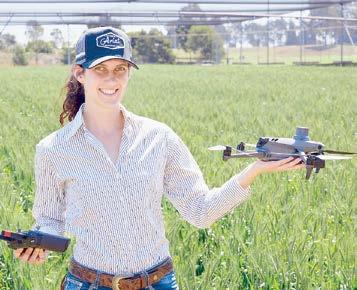
By Breanna Lloyd
This year’s Rockhampton Brahman Week Bull Sale has finally come to an end, leaving vendors, buyers and livestock agents proud to be in the Brahman breed after a 26-month-old 796kg red bull achieved a top price of $90,000.
Throughout the three-day sale held from Monday 7 to Wednesday 9 October at CQLX Saleyards, Gracemere, 748 lots of red and grey Brahman bulls were put under the spotlight for bidders from across the nation.
Muan A Corvette 7788, lot 671, was offered by Gibbs Farming Co, Biggenden, and achieved the top price bull, selling for $90,000 to W and GJ Kirkwood of Somerview Red Brahmans, auctioned by Elders on day three.
Muan A Corvette is sired from Mt Callan Usher and damed Muan A Miss Noble 6805.
While Brahman producers, studs and commercial operators gathered from across New South Wales and the state, a large number of commercial producers from the Northern Territory made a prominent presence at this year’s sale leaving an overall 93 per cent clearance rate, $10,477 average and gross of $6,892,000.
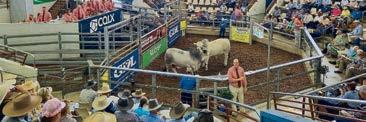
Grant Daniel and Long stud stock agent Georgie Connor believes this has left an increase in the sales overall average.
“We are about $500 above last year’s sale which is a reflection of the better season producers have had this year,” she said.
The second top-priced bull overall was also taken out by the red Brahmans on day three, for Mountain Springs Alton, lot 784, a 27-month-old 920kg beast offered by EE and JM Mollenhagen
and Sons, Monto, sold to BW and GJ Kirkwood, Charters Towers for $80,000, auctioned by Elders.
The top-priced bull for the grey Brahmans sold for $70,000 to Kenilworth Brahmans, Mount Coolon from Tony and Kathryn Mortimer, Dalma on day one.
Token Oscar, lot 265, is a polled 29-month-old bull weighing 922kg with a scrotum size of 41cm.
Oscar is sired from LMC Polled Sambo and damed Starbra Tor Cindy.
Coming in at the second top-priced grey bull was Clukan T Hunt, lot 419, a 25-month-old 856kg beast, offered by the Taylor Partnership, Jambin, purchased by Koolyn, Malarga for $50,000 on day two.
Nutrien Livestock agent Dane Pearce said it was a great result with a solid clearance rate and healthy average.
“We saw a lot of stud bulls here but what’s really important for the sale was seeing how much commercial support there was,” he said.
“Some of those bulk buyers we haven’t seen for a couple of years are beginning to come back to the sale which is fantastic to see.”
Australian Brahman Breeders Association executive Reade Radel agreed with Mr Pearce and said there were patches of the sale where it was definitely a biased market.
“Those people get to go home with terrific value for money and that’s what made the week so special,” he said.
“The commercial support is what keeps the industry and the breed going.
“Value for money, that’s the secret to Brahman Week.”
• Day one sale results
• Grey bulls
• Offered 250 bulls and sold 228 (91 per cent clearance rate)
• $9912 average
• $2,260,000 gross
• Top priced bull
Token Oscar, lot 265, offered by Tony and Kathryn Mortimer, Dalma, sold to Kenilworth Brahmans of Mt Coolon for $70,000 Day two sale results
Day three sale results
• Red bulls
• Red and grey bulls
• Offered 251 bulls and sold 236 (94 per cent clearance rate)
• $10,623 average
• $2, 519,000 gross
• Top priced bull Jomanda Unlimited, lot 445, offered by MA and DM Johnson and family, Grafton, sold to Anne Sutherland of Gympie for $55,000
• Offered 244 bulls and sold 219 (90 per cent clearance rate)
• $9575 average
• Top priced bull
Muan A Corvette 7788, lot 671, offered by
Gibbs Farming Co, Biggenden, sold to BW and GJ Kirkwood of Somerview Red Brahmans for $90,000
Overall sale results
• Offered 748 red and grey bulls and sold 683 (93 per cent clearance)
• $10,477 average
• $6,892,000 gross
• Top priced bull overall Muan A Corvette 7788, lot 671, offered by Gibbs Farming Co, Biggenden, sold to BW and GJ Kirkwood of Somerview Red Brahmans for $90,000
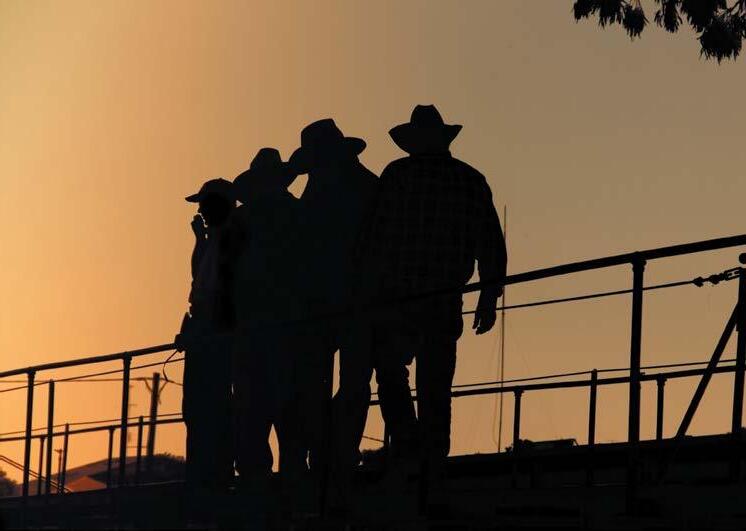
you have a story to tell, new projects to talk about or just simply highlight an achievement....
Fiona Gowers | E: fiona.gowers@queenslandfarmertoday.com.au
Breanna Lloyd | E: breanna.lloyd@queenslandfarmertoday.com.au
For all your classified and advertising enquiries, contact our team.
Jane Lowe
P: 0408 488 609
E: jane.lowe@queenslandfarmertoday.com.au
Samantha Wantling
P: 0439 420 289
E: samantha.wantling@warwickstanthorpetoday.com.au
Cindy Unwin
P: 0408 281 861
E: cindy.unwin@cqtoday.com.au
Daniel Pelcl
P: 0408 956 830
E: daniel.pelcl@burnetttoday.com.au
Classified Advertising
Sharon Jones
P: 07 4182 0451
17,000 copies published. Inserted into the following newspapers:
• South Burnett Today
• Central & North Burnett Today
• Warwick Today
• Stanthorpe Today
• Leader Today
• Jimboomba Today
• Beaudesert Times
• Emerald Today
• CQ Today
• Goondiwindi Argus
Also available from the follow outlets:
• Hartleys Newsexpress Toowoomba
• Roma Sale Yards
• Warwick Sale Yards
• Highfields News & Post
• Pittsworth Newsagency
• News Extra Central City
E: sharon.jones@burnetttoday.com.au Next Edition out on August 29, 2024



By Breanna Lloyd
This year’s Kandanga Valley Charolais and Charbray fifth on-property ‘Summer’ bull sale will be held earlier this year, on Saturday, 7 December, commencing 10am.
In total, 70 beefy young bulls have been catalogued for this year’s ‘Summer’ sale, all of which have been sensibly prepared on quality hay and a specially designed high roughage diet supplied by Norco, Windera.
Amongst the 70 extraordinary bulls are 40 Charolais bulls with 23 that are polled or poll scurred, including five homozygous polled and 30 Charbray bulls with 14 that are polled or poll scurred.
All bulls are vaccinated with three-germ blood, three-day sickness, Vibrio and seven-inone and will be semen motility and morphology tested three weeks prior to sale day, along with weights and muscle and fat scans.
Co-stud principal John Mercer said the Charolais are complete meat machines. “These bulls would be excellent for crossing over Bos Indicus females, plus there are low birth weight bulls in the line that would also suit the heifer job,” John said.
“The Charbray bulls are typical Kandanga Valley types designed to perform in more rugged environments where Charolais bulls may struggle they still display excellent muscling and weight for age to go on breeding heavy weaners well
sought after at markets all around Queensland and northern New South Wales.”
The bulls are reared on ticky, coastal country and are renowned for their survivability and constitution especially in northern and coastal breeder herds.
“All the bulls display that good soft Kandanga Valley muscling plus have great tidy sheaths for that extra longevity,” John said.
“Free delivery will be arranged to many centres, north to Sarina and west to Roma plus locally.”
Located in the Gympie district, John and costud principal Roz Mercer have been breeding Charolais and Charbray bulls for 36 years with their herd now consisting of over 1300 head.
Turning off over 180 bulls each year, John believes next season they will offer 300 bulls for sale.
The pairs motto at their first on-property sale was ‘Bulls are our Business’ and things certainly haven’t changed.
John explained why he and Roz decided to sell in December rather than January.
“We have it in this time of year to beat the wet season and extreme humidity that can happen at Kandanga most summers,” he said.
“Anyone who missed out on bulls at the southern sales or has had older bulls fail their vet checks, or northern buyers just looking for fresh young bulls ready to put straight into cycling cows or heifers, should take a look at these quality flatback bulls.”




This year has already seen late frosts and heavy rain, and now the latest prediction from the Bureau of Meteorology BOM is for our hottest summer on record.
The possibility of more extreme weather patterns, including withering heatwaves and flash floods present many challenges for farmers. Here in Australia, we must be prepared for the worst events including uncontrollable fires, devastating floods or the ever-present risk of drought. One company that recognises that need is Australian Pump Industries.
AUSSIE PUMPS ARE READY
Aussie Pumps is mobilising to meet what could be the most erratic weather conditions in years. Working with trained and experienced Distributors, their plan is to encourage and support farmers and regional homeowners to be prepared!
Although the company gives full credit and huge respect to the professional firefighters and volunteers in the community, it’s not possible for these folk to be everywhere at once in the event of a major disaster.
BE ARMED IN ADVANCE
Being prepared is everything and that means first and foremost having the right equipment and the right plan.
“We know that some customers think that an expensive fire pump must be good. It doesn’t necessarily work that way and we encourage farmers and homeowners to check the performance of the products they are buying. Look below the surface, check the performance curves, read the technical documentation and take the trouble to understand the limitations imposed by friction loss, pump size and horsepower”, said Aussie Pumps Chief Engineer, John Hales.
Aussie Pumps first started producing fire pumps over 30 years ago with the basic formula of using quality components driven by the world’s best engines. It led to ready acceptance of their pumps by both commercial and Government authorities. Contracts from the firefighting authorities and National Parks quickly followed!
Many of the company’s staff live in what is known as the “Urban Interface”. Some are “blockies” with livestock and have experienced first hand bushfires in the last 20 years. It’s that experience and working closely with professionals that has given the company insight into what is required in terms of pump performance and reliability.
BRING ON THE BIG GUNS
Aussie developed the Brigade Boss range of high pressure pumps first and foremost to help farmers concerned about crop protection. The company understands the heartbreak of investing heavily in both labour and funds, to see a crop burn before your eyes. The Brigade Boss range deliver big flows at high pressure.
For example, Aussie’s QP402 4” high flow version of the pump, provides the ability to fill tankers fast with flows of up to 1800 lpm. In its high pressure version, with closed vane impeller and volute will handle heads as high as 70m (al-

most 100 psi).
The pumps can be powered by either Honda petrol and Yanmar diesel drives and provide tremendous capability, not just for fighting fires but also for long distance water transfer and to fill tankers fast.
AUSSIE GOES DIESEL
Recognising the trend of firefighting authorities towards diesel drives because of their intrinsic safety factors (lower fuel volatility), the Aussie team moved towards a close association with key diesel engine manufacturers. Their pumps are powered by top brands like Hatz, Yanmar and Kubota diesel.
Diesels can also deliver better fuel economy and, if properly serviced, can last many years before needing to be replaced.
BUYER BEWARE
Australian lightweight portable fire pumps are now copied by third world players.
“You won’t find those products at any reputable pump supplier and certainly not amongst the Aussie Pumps authorised dealerships”, said Hales. “Everywhere we hear the mantra from the market that it’s better to pay a little more and get the right product the first time. We believe in the quality of our pumps and that’s why all Aussie’s Quik Prime pump ends are backed up by a five year warranty, he said.
AUSSIE’S FIRE SURVIVAL GUIDE … IT’S FREE
This indispensable guide provides information on how to protect both farm and Urban Interface properties. Now in its 2024 edition, Aussie continues to build additional information in the guide. It’s based on real life experiences from professional firefighters, volunteers and homeowners working towards protecting property and lives.
The Survival Guide helps to select the right equipment, from pumps and engines to hose and nozzle kits, all aimed at getting the very best result in an emergency.
DROUGHTS AND FLOODS
Everyone understands that without reliable access to sufficient water, Australia’s farms will become less productive and less viable. Aussie Pumps has zealously campaigned for water security for the country, pushing for action from politicians to think beyond their 3 year term. It’s an issue raised over 70 or 80 years ago when our forefathers planned to build more dams, diverting rivers into the inland where water security is most needed.
“With the equipment we have today, in terms of tunnelling and excavation gear, this is absolutely possible and only requires money and the will to carry it out”, said Hales. “Imagine the afforestation programs we could run and how that could play a vital role in our battle with climate

change”, said Hales. For copies of Aussie’s “Water Security for Australia” stories, free Bushfire Survival Guides or information on Aussie’s product range, contact authorised Aussie Pump Distributors throughout Queensland.
• 165CM - 5’6” BLACK - HEAVY - $7.50
• 180CM - 6’ BLACK - HEAVY - $8.50
• 180CM - 6’ HDG - HEAVY - $9.00
• 8.2MM-7 STRAND GALV
125 X 75 X 5 - PTD - $250
24 - 4.7M - 127 X 51 X 3 - BLACK - $80
• 115 X 42 X 1.8 - 6.1M - $55 LEN
• 115 X 42 X 2.0 - 6.1M - $60 LEN
• 115 X 42 X 2.5 - 6.1M - $70 LEN BUNDLES 21 LENS ONLY
• 1.8M X 2.1M - 6 RAIL
• 40 X 40 - GALV RHS
• PINS INCLUDED 92 - PACK BUYS - $85EA
LOOSE BUYS - $100EA
• SLIDE GATE - $400EA
• 1.2M X 2.2M
• 8 RAIL - GRADUATED
• 2.5MM OD - GALV PIPE
• PINS INCLUDED PACK BUYS - 93 - $90EA LOOSE BUYS - $100EA
• GOAT PANEL GATE - $250
• 10’-3M - MESH - $120
• 12’-3.6M - MESH -$140
• 14-4.2M - MESH -$160
• 10-3M - 5 BAR LIGHT -$140
• 12’-3.6M - 5 BAR LIGHT -$160
• 14-4.2M - 5 BAR LIGHT - $190
• 12’-3.6M - 5 BAR HEAVY -$180
• 14-4.2M - 5 BAR HEAVY -$210
• 400M X 150 KG - $550 HINGED JOINT/ FIELD FENCE FIXED KNOT

• 4M X 2M-800 KG - $2700 CONCRETE ABUTMENTS 4M-3000KG/PAIR - $1600
• 3000 X 600 - $200 • 3000 X 750 - $220
• 9-8M-125 X 125 X 4-GALV -$160
•2.4M -80NBX4MM-GALV -$65 •3M -80NBX4MM-GALV
• 2.5MM-IOWA-400M ROLLS
PALLET BUYS - 27 ROLLS - $125EA SINGLE ROLLS - $135EA
• 1.8MM - HIT - 500M ROLLS
PALLET BUYS - 36 ROLLS - $115EA SINGLE ROLLS - $125EA



2024 Spring Sale Results:
Glenlea Beef and Fairfield Charolais
Glenlea Beef celebrates 50 years of continuous Charolais seedstock production and registration across three states this year.
The stud was founded in Tasmania in 1973, before Roderick Binny relocated the herd to northern NSW in 2010. Now numbering 1,000 purebred Charolais cows, Glenlea Beef has the scale to provide seedstock to all sectors of the industry.
OVERALL RESULTS
Glenlea Beef and Fairfield Charolais, Winton Sale, Friday, 19 July. Sold all 35 bulls offered, with an average of $9,557.
TOP PRICE
Glenlea Phoenix T318, a 23-month-old red Charolais bull, sold for $17,000 to KWG Contractors, Beauford Station, Alpha.
OVERALL RESULTS
Glenlea Beef and Fairfield Charolais, Clermont Sale, Friday, 16 August. Out of the 33 polled Charolais and four Simmentals offered, 23 bulls were sold, with an average of $6,935.
TOP PRICE
Glenlea Fairfield Phoenix U6, an 18-month-old polled bull, was purchased for $12,000 by Shane Benney, Merrigang, Clermont.
OVERALL RESULTS
Glenlea Beef and Fairfield Charolais, Roma Sale, Wednesday, 18 September. On offer were 64 Charolais, red Charolais, composite Charolais, and Anguscross bulls. Of these, 59 lots were sold under the hammer, resulting in a 92 per cent clearance rate. The average sale price was $7,459, representing an increase of nearly $200 compared to last year.
TOP PRICE
Glenlea Jr T243, a 23-month-old bull weighing 860kg, was the top-priced bull, selling for $22,000 to Chris Hall of Nymboida, New South Wales.
VENDOR COMMENT
“The whole Glenlea team would like to thank all buyers and underbidders, and we look forward to 2025 with a large selection of new genetics featuring sons of our imported sire SCX JEHU,” said Roderick Binny.
Carabar Angus
Founded in 2001 by the Hegarty family in Meandarra, Queensland, Carabar Angus Stud strives to produce top-quality Angus cattle that meet MSA standards. They specialise in Angus genetics, selecting only the finest bulls and cows for their breeding program.
OVERALL RESULT
Eighth annual on-property Carabar bull sale, Friday, 27 September
Out of the 71 bulls offered, 66 were sold, resulting in a 93 per cent clearance rate and an average of $9,439.
TOP PRICE
Carabar Iceman T233, an AI son of 2021 Australian Angus record-breaking bull Texas Iceman, sold for $18,000 to the Meandarra stud.
VENDOR COMMENT
“Thank you to everyone who attended the sale today and those who bid on AuctionsPlus,” said Darren Hegarty.
Weetalabah Cattle
Breeding poll Gelbvieh cattle for the commercial industry, with high milk production, sound udders, correct structure, and good doability.
The temperament of our cattle is paramount, with no excuses. Horned and polled Hereford bulls are also occasionally available.
OVERALL RESULTS
Golden Advantage Sale, Thursday, 10 October
A total of 30 bulls were offered, comprising 18 purebred Gelbvieh bulls and 12 crossbred bulls. The majority were polled and paddock-reared, with a 62 per cent clearance rate achieved. Eight crossbred bulls sold for an average of $2,375, and 10 purebred bulls sold for an average of $5,100.
TOP PRICE
The top price was $6,500 for a Calveston crossbred Gelbvieh bull, a 16-month-old horned red bull.
Ascot Cattle Co
We are a customer-focused Angus and Charolais breeding operation, aiming to deliver low-risk, thick, polled bulls bred with an MSA-targeted approach. Our breeding headquarters are located at North Toolburra Station, Warwick, QLD, comprising 400 stud breeders.
OVERALL RESULTS
All Polled Ascot Spring Bull Sale, Friday, 20 September
All 73 Angus bulls offered were sold under the hammer, averaging $17,328. The Angus females achieved a 100 per cent clearance rate, with an average of $9,935 and a top price of $30,000.
The Charolais bulls also achieved 100 per cent clearance, with all 65 lots sold, averaging $16,892. Charolais females had a 97 per cent clearance
rate, with 28 of 29 sold, averaging $4,821 and a top price of $8,000 to Yaccamunda Investments.
TOP PRICE
Ascot Universe U302, lot 33, was the top-priced bull, selling for $40,000 to Metcalfe Pastoral.
Universe U302 is a registered stud sire, sired by Dunoon Prime Minister P758 and out of Ascot Brenda R307.
VENDOR COMMENT
“We would like to sincerely thank our hardworking team—Clint Glenn, Tommy, Sarah Henry, and the Scots College parents and students for helping with the catering. We also thank Oga Creative for their shared vision with our brand, as well as our buyers, underbidders, and agents,” said Jim and Jackie Wedge. We were very pleased that our bulls and heifers, born and raised with care and dedication, went to great homes.”
Talana Limousins
Since 1993, Talana Limousins has worked to produce cattle better suited to Queensland conditions, steadily adapting them to the local environment and markets. Over the years, the Grahams have refined their Limousin cattle to determine what type is best suited to the region.
OVERALL RESULTS
Talana Limousins bull sale, Thursday, 19 September. All 24 bulls offered were sold under the hammer, setting an Australian breed record with an average of $10,354.
TOP PRICE
Talana Poll Polo, a 28-month-old French Pure bull weighing 944kg, was the top-priced bull, selling for $20,000 to Lawrence and Pat Hack of Rocklea, Alpha. Bunya Droughtmaster Bull Sale
OVERALL RESULTS
11th Annual Bunya Droughtmaster Bull Sale, Saturday, 7 September. A total of 71 bulls were offered at the Coolabunia Selling Complex, Kingaroy, with 56 bulls sold under the hammer and heading to new homes across the state.
TOP VENDOR AVERAGES
1. Vale View M - $13,000 for his single entry
2. Diamond Hill - $9,666 for three bulls
3. Caldy - $8,500 for four bulls
4. Vale View - $8,333 for three bulls
5. Sylvan Springs - $8,000 for two bulls
TOP PRICE
Vale View Gibbo 2, lot 36, offered by Dave and Colleen Smith of Vale View Droughtmasters, Manumbar, achieved the top price of $13,000. The 23-month-old bull, weighing 800kg, sold to Alan and Marj Martin, Burrandowan. Gibbo 2 is a milk tooth bull with an EMA scan of 134cm², fat measurements of 13/8, and an IMF of 5.5 per cent.
VENDOR COMMENTS
“A big thanks to all those who supported the sale, including buyers, vendors, sponsors, and selling agents GDL Stud Stock, Aussie Land and Livestock, and Stocklive,” the Bunya Sales Group said.
“Thanks also to those who attended and supported the Kilkivan State School Cattle Show Team – a quality group of students, teachers, and volunteers.”
Belmont Red Association Bull Sale
OVERALL RESULTS
Annual Belmont Red Association bull sale, Monday, 2 September
This year’s sale saw an increase in the average, with all 34 bulls sold under the hammer, reaching an average price of $9,558.
TOP PRICE
RJS230013 Wahroonga 230013, lot 14, offered by Robert and Jane Sherry of Wahroonga Belmont Reds, Clarke Creek, topped the sale at $20,000, selling to Maynard Senepols, Jambin. Wahroonga 230013 is sired by SEI130061 Seifert Belmont Reds 130061 and out of RJS190012 Wahroonga 190012. The Grove Shorthorns
The Morgan family has been breeding Shorthorns in Queensland for over a century, determined to see The Grove’s influence on the beef industry continue. By combining strict visual evaluation with performance recording of large contemporary groups, The Grove can accurately describe their cattle’s genetic potential, allowing them to breed the desired phenotype with greater certainty.
OVERALL RESULTS
Annual on-property bull sale, Thursday, 19 September. The Grove sold all 103 bulls offered, with an increase in the sale average, which sat at $13,417.
TOP PRICE
This year, the top price of $45,000 was reached twice for two-year-old bulls. The Grove T0466, a red bull weighing 1037kg with a scrotal circumference of 42cm, was purchased by Deepwater Farming, Brownlie family, Meandarra. The Grove Teller T0412, a red bull weighing 982kg, was purchased by NSW stud Weebollabolla for $45,000.
Karbullah Poll Merinos
Mark and Vicki Murphy established Karbullah Poll Merinos in 2001, located 70km north of Goondi-
windi. Their dual-purpose Merino stud produces around 1,100 stud and commercial ewes and 300 rams annually on their 8,000-acre Brigalow and Belah property. The Murphys focus on high productivity traits, superior wool quality, unique carcass characteristics, strong fertility, and survival instincts in their breeding program.
OVERALL RESULTS
Annual on-farm ram sale, Monday, 16 September
The Murphy family achieved a 100 per cent clearance rate from the 150 rams offered, with an average price of $1,674.66 per head. ST and A Murphy, Mungindi, were the volume buyers. A total of 85-grade rams were sold during the sale.
TOP PRICE
The top-priced ram, lot 50, sold for $4,000 to John and Sheena Allen, Kioma. The ram ranked in the top 5 per cent for YEMD, YFAT, and YWEC, and the top 20 per cent for YSL, with a 17.1-micron fleece and a 100 per cent comfort factor.
VENDOR COMMENTS
“We are very pleased to see all the boys going to good homes and being put to work,” Mr and Mrs Murphy said. “We’d like to thank McCulloch Agencies and StockLive for their support and efforts leading up to and during the sale, and to studstocksales.com for the photos and videos that made online purchasing easier.”
Bellevue Dorpers
Bellevue is a mixed agricultural enterprise run by lifelong farmers David and Robbie Curtis and their daughter Sophie. Bellevue Dorpers and White Dorper Stud, along with a commercial ewe enterprise producing MSA-accredited prime Dorper lamb, form the core of their business, which also includes summer and winter grain rotations, some of which are undergoing organic certification.
OVERALL RESULTS
Annual on-farm ram sale, Thursday, 26 September Bellevue achieved a 100 per cent clearance rate for all 120 Dorper and White Dorper rams offered.
The 60 Dorper rams averaged $2,080, with a top price of $3,800 for lot four, purchased by the Bryant family, Mitchell. The White Dorper rams averaged $2,140, with a top price of $4,400 for lot nine, purchased by Stillwater Ellangowan.
VENDOR COMMENTS
“We are so grateful and truly appreciate your support, and we wish everyone the best with their purchases,” David and Robbie Curtis said. “To the Bellevue team, our family and friends – thank you for your wonderful help, we couldn’t have done it without you.”
47th Annual National Charbray Sale
OVERALL RESULTS
Monday, 30 September
The sale saw a 96 per cent clearance rate, with 72 out of 75 bulls sold at the CQLX Saleyards, Gracemere. The sale average was $9,826, with a gross of $707,500.
TOP PRICE
Trifecta Trojan, a 25-month-old heterozygous polled bull weighing 902kg with a 40cm scrotal circumference, was the top-priced bull, selling for $32,500 to John and Roz Mercer, Kandanga Valley, Gympie. Trifecta Trojan was offered by Bryce and Lucy Moore of Trifecta Charbrays, Mungallala.
VENDOR COMMENTS
“Achieving this is something all stud principals aspire to,” Bryce and Lucy said. “We feel privileged to have done so among such a strong, consistent line of Charbray seedstock and among such committed, passionate fellow stud producers.”
Queensland Red Angus Power of Red X Sale
OVERALL RESULTS
Saturday, 14 September
For the 10th annual Power of Red sale, 21 out of the 26 lots were sold, achieving an 81 per cent clearance rate with an average price of $8,857. Seven of the nine females offered were sold, reaching a 78 per cent clearance rate with an average of $4,857.
TOP PRICE
Boonyouin Trailblazer T21, a 23-month-old bull weighing 780kg, topped the sale at $14,000. It was sold to Heather Davies, Rosemullion Red Angus, Goomburra, and offered by Maryanne Kearney, Boonyouin Red Angus, Kingaroy.
Bulliac Angus
Bulliac Angus operates its home base and bull preparation unit at “Wandaloo“ and “Wilga Dale“ east of Miles, Queensland. The cow herd is managed by the Hill and Bidgood families, spread across several properties in Miles, Uralla, and Emerald.
OVERALL SALE RESULTS
Annual bull sale, Thursday, 26 September.
A total of 93 out of 115 bulls were sold, achieving an 81 per cent clearance rate with an average of $7,860, resulting in a gross of $731,000.
TOP PRICE
Bulliac Timberlake T122, lot 72, was the top-priced bull, selling for $19,000 to Brownleigh Farming and Grazing, Moree, NSW.

VENDOR COMMENTS
“Our sincere thanks to all buyers and everyone who attended today,” Bulliac Angus said. “We are humbled by the strong support from repeat buyers.”
Brisbane Valley Santa Gertrudis Bull Sale
OVERALL RESULTS
Wednesday, 18 September. This year’s sale achieved a 94 per cent clearance rate, with an average selling price of $8,161.
TOP PRICE
Welbatch Yes Sir, lot 28, sold for $20,000 to Robert Lord, Kilterry Station, Julia Creek, offered by Welbatch Pastoral, Mummulgum, NSW.
The second-highest price bull, Welbatch Yellowstone, sold for $19,000 to Ruby Red Brangus.
Droughtmaster Diamond Genetics Sale
OVERALL RESULTS
Saturday, 28 September
The second annual Droughtmaster Diamond Genetics Sale sold 22 out of 34 bulls, achieving a 65 per cent clearance rate with an average price of $5,864. The female section saw 23 of 43 lots sold, reaching a 53.5 per cent clearance rate with an average price of $3,696.
TOP PRICE
The top price of $12,000 was reached twice. Diamond Hill Banjo, lot 24, was sold to Tomawill and Ironhide Droughtmasters, and Major Checkmate, lot 28, was sold to Leon Brennan, both offered by Major Droughtmasters.
Pathfinder Angus
Pathfinder Angus is a seedstock beef cattle business based near Penshurst, Victoria, with three annual bull sales in Victoria, South Australia, and at Roma, Queensland. It is owned and operated by Nick and Sara Moyle and their family.
OVERALL RESULTS
Friday, 20 September. At the 10th annual sale, 104 out of 106 bulls were sold, achieving a 98 per cent clearance rate with an average of $8,950. The top price reached $21,000.
VENDOR COMMENTS
“The Pathfinder Team would like to thank all the purchasers and underbidders for their ongoing support of our Pathfinder program,” Pathfinder Angus said.
Glenisa Angus
Established in 1994, Glenisa Angus is owned by Ced Wise and family. Originally a stone fruit orchard and vineyard, the property ‘Glenisa’ has evolved into the centre of Glenisa Angus’ stud and commercial operation, spanning 10,000 acres of semi-improved properties.
OVERALL RESULTS
Bull and commercial female sale, Friday, 6 September. The Glenisa Angus bull sale achieved a 98 per cent clearance rate, with 38 out of 40 lots sold, averaging $10,473 and grossing $398,000. The commercial Angus weaner heifers achieved a 100 per cent clearance rate, selling all 50 lots at an average price of $1,760, grossing $48,000.
TOP PRICE
Repeat buyers, the Nobbs family of Yeoman Cattle Company, Bauhinia, purchased the top-priced bull, Glenisa Tex Powerplay U202, for $30,000. The 18-month-old son of $108,000 Texas Powerplay weighed 808kg.
VENDOR COMMENTS
“We received great support from both repeat and new buyers of Glenisa genetics,” the Glenisa team said.
“We wish you every success with your purchases and look forward to catching up with you to see how your stock matures and performs.”
Broadwater Angus
Although newcomers to the stud stock scene, Broadwater Angus has been involved in breeding and feeding cattle for over 20 years. Their business has evolved from growing out steers for the local butcher trade to a stud Angus breeding operation.
OVERALL RESULTS
Annual on-property bull sale, Friday, 6 September
The third annual sale achieved a 58 per cent clearance rate, selling 25 out of 43 bulls with an average price of $7,760, grossing $194,000.
TOP PRICE
Broadwater Terra Firma T120 sold as the top-priced bull, fetching $19,000 from Paul Cleary, Southern Downs.
Cooninda Santa Gertrudis
OVERALL RESULTS
Annual on-property bull sale, Monday, 23 September. The 14th annual sale saw 44 out of 54 bulls sold, reaching an 81 per cent clearance rate with an average price of $9,340, grossing $411,000.
TOP PRICE
The top price of $26,000 was reached twice during the sale. Cooninda Front U250, lot one, sold to Lance Kim and Neil Baker of Woodmillar Santa Gertrudis Stud, Gayndah. Cooninda Unit U500, a 25-monthold poll-scurred bull, lot 19, was sold for the same price to Golden Pastoral Holdings, Nullin, Yuleba.


Beef2024 was a highlight for Brian and Jasmin Kaddatz and their family of Merrindale Gelbvieh when their Kadfarm Gelbvieh Spartan won the bull category for 30 months and under 36 months, and then went on to win Grand Champion Gelbvieh bull.
“This was a wonderful conclusion to the year and a mark of recognition for a journey that began over 30 years ago when Brian’s parents, Brice and Frances Kaddatz, brought the Gelbvieh breed to the northern tropics and began a crossbreeding program with the Brahman breed,” Jasmin said.
The Kaddatz program has been built with the commercial cattle industry in mind, utilising events like the Gympie Carcass Classic as an educational and information-gathering tool to maximise profitability for their herd. They use this data to select bulls and females, benefiting their end users—the commercial cattle producers.
“This also makes our crossbred cattle wellsuited for any climatic condition in Australia,” Jasmin said.
“We have made a conscious decision to use registered animals on both sides of our crossbreeding program to provide the best information to our customers.”
Gelbvieh cattle have been involved in trials around the world, and the information gathered has made them one of the best breeds for use in various crossbreeding programs.
Not only do they add the benefits of their own breed, but they also magnify the strengths of the breed they are crossed with.
So much so, the Balancer (Gelbvieh x Angus) has its own herd book in North America and is rapidly spreading around the world as one of the best production animals for commercial producers.
They complement both British and tropical breeds, making them highly versatile.
The Gelbvieh breed has become one of the most utilised in the USA for composite breeding, ensuring maximised profits.
Gelbvieh cattle are known for their quiet and inquisitive temperament.
They excel in many major traits, contributing excellent maternal qualities, such as high fertility, early puberty, and good milk production.
The breed also combines lower birth weight with explosive, curve-bending growth rates, producing heavy, well-muscled progeny with optimal finishing ability.
“We place a lot of emphasis on our cow families and the maternal capabilities of the breed,” Brian said.
“We believe the value of a bull is largely determined by his mother and the daughters he will sire.”
At Merrindale, the Kaddatz family also focuses on foot and udder quality, as well as structure and phenotype.
The Australian Gelbvieh Breed Society has recently transitioned to the IGS data system, which is used by both the American and Canadian societies.
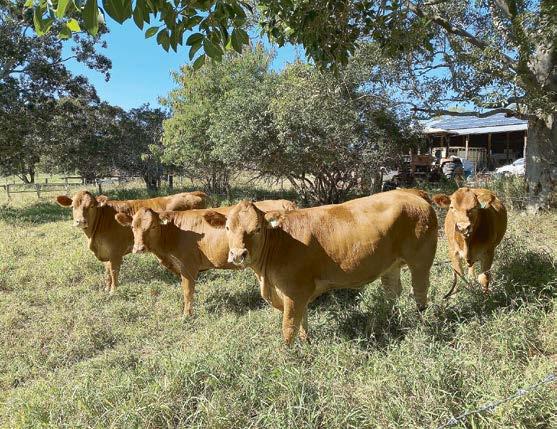
This system offers the most comprehensive data pool available.
When combined with DNA collection, which is now a key part of the breed’s resources, it provides Australian breeders with critical information for their breeding programs.
“We know our commercial customers value these traits, and we believe it is our responsibility as seedstock producers to go above and beyond in providing the necessary data,” Brian said.
Brian and Jasmin recently attended Agribition in Canada, which has partnered with Beef Australia.
It proved to be a pivotal experience for the Australian Gelbvieh group, as breeders embarked on a journey of exploration, collaboration, and knowledge exchange.
The tour, which began in November 2023, saw the Australian delegation—led by Brian and Jas-
min—arrive in Regina for a week of insightful engagements and strategic discussions.
The primary focus of the trip was to forge partnerships with prominent Canadian Gelbvieh breeders and explore opportunities for introducing outcross genetics into Australia.
Brian and Jasmin returned with a wealth of information and a clear vision for the breed and their customers.
Beyond visual assessments, discussions centred around potential collaboration in genetic exchange, including embryos and semen, with a focus on securing Australian rights.
This exchange not only demonstrated a commitment to enhancing genetic diversity in Australia but also highlighted the collaborative spirit that defines the global Gelbvieh community.
The trip provided an invaluable firsthand understanding of the breeding philosophies and
operational intricacies of the ranches they visited.
This multifaceted approach underscored the depth of consideration in their efforts to enhance and diversify the Gelbvieh landscape in Australia.
Engaging with fellow breeders, they delved into bloodlines and explored potential export opportunities.
Gelbvieh cattle range in colour from a golden honey shade through to deep, rich red and also black.
This makes them ideal for crossing with most breeds to produce an even, solid colour that gives a uniformappearancein the paddockandsaleyards.
“Gelbvieh is a unique breed in the beef industry, not only for the invaluable traits it brings to a commercial breeding program but also for the way it enhances the best traits of any breed it is combined with,” Brian said.
Budding young scientists turned their minds to sustainable fishing and farming as part of this year’s Hermitage Research Facility Plant Science Competition.
More than 3500 students, ranging from prep to year 12, participated in this year’s competition, with 129 schools from across Australia represented.
Winners were announced today (1 October, 2024) at a special event at the Department of Agriculture and Fisheries (DAF) Hermitage Research Facility.
Competing in a range of categories, students experienced first-hand the important role aquaculture and agriculture play in food security, and how sustainable fishing and farming practices protect vital ecosystems.
Two new awards were offered this year, the Alan Cruickshank Memorial ‘Germinator’ Outstanding STEM Teacher Award and the Earthwatch Student Challenge Fellowship.
The Alan Cruickshank Memorial ’Germinator’ Outstanding STEM Teacher Award is sponsored by the family of former DAF senior plant breeder Alan Cruickshank and recognises the special role teachers play in germinating students’ interest and achievement in STEM. Jade King, agriculture teacher from the Glasshouse Christian College, won the $1000 prize for professional development.
The Earthwatch Student Challenge Fellowship, sponsored by Earthwatch Australia, gives one student the opportunity to experience environmental research first-hand.
The winner, year 12 student Maisie Atwell from Clifton State High School, will work alongside leading scientists in a week-long expedition this year along the banks of the Murray River in South Australia; an experience valued at $5000.
Other major individual science prizes were awarded to students from across Australia.
The competition’s Art in AgRiculTure section saw students intertwine science with art to create fin-tastic, fisheries-themed artworks, resulting in a gill-iant collection of pencil sketches, paintings, sculptures and storybooks.
Students from Glennie Heights State School and Warwick West State School won the top art prizes of ‘Most Outstanding School’, with Warwick East State School and Coffs Harbour Christian Community School receiving runner-up prizes.
A third component of the competition, in partnership with Guardians of Earth, involved students worldwide participating in a citizen science biosecurity-themed adventure that involved monitoring animals and organisms that invade

plants via a mobile gaming app.
The 2024 Guardians of Earth ‘Pest Invaders’ BioQuest attracted 356 participants with 1194 species monitored.
Player ’The Owl Whisperer’ from Miallo State School in Far North Queensland was crowned the Overall BioQuest Champion, securing an environmental-themed experience in the Cairns region valued at $1000.
Hermitage Research Facility Schools Plant Science Competition major sponsors include DAF, Guardians of Earth, Earthwatch Australia, the Grains Research and Development Corporation and the Fisheries Research and Development Corporation.
Department of Agriculture and Fisheries Hermitage Research Facility spokesperson Kerrie Rubie said:
“This year’s science and art entries were exceptional and inspires great hope for the future of science and agriculture,“ she said.
“These aspiring young scientists have learned about the importance of sustainable fisheries and farming for future food security.
“Students were free to explore any area of interest under the theme of ’fishing and farming for the future’ or follow our pre-designed experiments and research activities and submit a scientific report on their findings.
“It’s inspiring to see this level of enthusiasm
for science and it bodes well for the future of our agricultural industries.“
Major science award prize winners:
• Alan Cruickshank Memorial ’Germinator’ Outstanding STEM Teacher Award ($1000 value): Jade King, Agriculture teacher, Glasshouse Christian College (QLD)
• Earthwatch Student Challenge Fellowship ($5000 value): Maisie Atwell, year 12, Clifton State High School (QLD)
* Paul Johnston Memorial Senior Science Award ($1500 value):
• Winner: Yasmine Brockhurst, year 10, Child Challenger Homeschool (QLD)
• Runner-up: Ruby Klein, year 11, Glasshouse Christian College (QLD)
• * SQLD Rabo Client Council Conference Award ($1000 value): Eva Young, year 10, Centenary Heights State High School (QLD)
• * Conference Award ($1000 value): Tia Stephens, year 12, Harristown State High School (QLD)
* Crawford Fund International Agricultural Science Award ($1000 value):
• Winners: Ruby Klein, year 11, Glasshouse Christian College (QLD), Abigail MacRae, year 5, Dalby State School (QLD)
• Runners-up: Olivia Watson-Brown, year 10, Glasshouse Christian College (QLD)
* QUT Most Outstanding Poster Awards ($1000 value):
• Winners: Ruby Klein, year 11, Glasshouse Christian College (QLD), Jordana Evans, year 9, Evans Homeschool (QLD), Aliyah Evans, year 6, Evans Homeschool (QLD), Ariel Evans, year 3, Evans Homeschool (QLD), Year 1, Glennie Heights State School (QLD)
• Runners-up: Yasmine Brockhurst, year 10, Child Challenger Homeschool (QLD), Keileigh Balmer, year 9, Rushworth P-12 College (VIC)
* Ag Institute of Australia Junior Science Achievement Award ($250 value):
• Winner: Jordana Evans, year 9, Evans Homeschool (QLD)
• Runner-up: Ian Connor, year 7, Murrumba State Secondary College (QLD)
* Joe Baker Outstanding Achievement Awards ($100 value):
• Winner years 3-6: Ariel Evans, year 3, and Aliyah Evans, year 6, Evans Homeschool (QLD)
• Winner years P-2: Irene Skoubourdis, year 2, Skoubourdis Homeschool (QLD)
* John and Chris Purdie Young Science Investigator Award ($200 value):
• Winner: Chelsey Poole, year 1, Glennie Heights State School (QLD)
• Runner-up: William Wilson, year 2, Pilton State School (QLD)
Angus Australia has announced the launch of Angus SteerSELECT.
This new product, available now, provides beef producers with confidence in determining the genetic potential of their Angus steers, allowing for more informed decisions across the beef supply chain.
Angus SteerSELECT delivers genomic-based genetic predictions for Angus steers covering the key trait areas of growth, feedlot performance, carcase attributes and resilience.
It has been developed for Angus steers that are 87.5 per cent, or higher, Angus content.
Angus SteerSELECT has been specifically developed to cater to Australian beef production systems, using extensive research and data gathered through Angus Australia’s reference population, which now includes over 300,000 genotyped animals.
This ensures that the tool provides the most accurate genetic predictions for Angus steers.
Angus Australia’s CEO Scott Wright explained that the launch of Angus SteerSELECT added to Angus Australia’s portfolio of geneticfocused tools for Australian and New Zealand Angus breeders and Angus beef supply chains.
This product builds on Angus Australia’s long history of providing world leading genetic evaluation solutions.
Mr Wright further highlighted the collaboration behind the tool:
“Angus SteerSELECT is the culmination of five years of collaboration between Angus Australia and the CSIRO, Australia’s National Science Agency,“ he said.

“Importantly, it leverages the genotype and phenotype reference population data curated by Angus Australia, including the rich dataset from the Angus Sire Benchmarking Program.”
Angus Australia’s general manager of Genetic Improvement Christian Duff explained that Angus SteerSELECT complemented the genetic selection tools already available, particularly Angus HeiferSELECT.
“Angus SteerSELECT provides genetic predictions across nine key traits important for Angus steer production.
“This is coupled with an overall Angus Steer Value (ASV), which encapsulates the overall genetic worth of each steer.”
He added that the tool also offered sire verification (where possible) and genomic breed composition to further enhance its value for
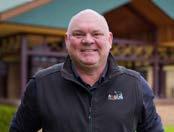
producers.
“Angus SteerSELECT can be accessed directly from Angus Australia or via our collaborating partners Zoetis Animal Genetics and Neogen Australasia,” Mr Duff said.
Angus SteerSELECT was developed and validated in the commercial environment, enabling greater precision in sorting and/or marketing of Angus steers into lines suitable for the different paths within the beef supply chain.
Rangers Valley’s Livestock Procurement manager William Schmidt said:
“We are excited about the possibility of being able to individually select commercial progeny for specific feeding programs.
“By identifying individual animal’s genetic potential, we hope to reduce our production cost of feeding cattle that are not suited to our long-fed programs.”

By Alex Mclaughlin
With the 2024 AFL Grand Final a battle between the Brisbane Lions and Sydney Swans, APlus News created a “starting nine“ line-up of cattle breeds from New South Wales and Queensland.
The breed ranking was based on the volume of listings offered across the platform since the start of 2024. However, several alternative performance indicators have been included to highlight the results recorded across the platform.
The ‘starting nine’ is a snapshot of all stock categories listed under each breed, which is important to keep in mind when considering the price points. Average prices are inclusive of all stock categories, which can be influenced by higher value selling articles.
Looking at the figures over the past year from 1 January, 2024, to 24 September, 2024, NSW has offered a greater volume of listings, with Angus cattle dominating the listings numbers across both states.
However, over the past nine months, Queensland has listed 19,626 head of Angus cattle. This year’s offerings have already surpassed the 16,791 head of Angus cattle listed on the platform in 2023.
The Angus breed leads by volume with 155,515
head at an average price of $1396 and a 79 per cent clearance rate. Meanwhile, Santa Gertrudis articles topped the clearance rate chart at 89pc.
The Santa Gertrudis breed also records the highest average price per head at $1498, with the price over reserve averaging 15.36pc above set reserve rates, indicating strong competition for Santa articles.
Santa Gertrudis articles this year have also recorded the highest value over reserve (VOR) at $286, which is an average of 15.4pc above set reserves. Hereford’s had the second highest value over reserve, achieving an average of $222.
This highlights strong demand for Angus, but higher premium potential in Santa Gertrudis over the past nine months.
Similarly to NSW, the Angus breed has dominated Queensland listings with 19,626 head offered, averaging $1,220/head and achieving a high clearance rate of 84pc.
The Santa Gertrudis breed has performed strongly, with a $1236/head average price and the highest clearance rate of 89pc. The Santa Gertrudis breed has achieved the highest clearance rate across both NSW and QLD.
Droughtmasters saw 12,810 head listed across the platform, averaging $1149/head, with a healthy clearance rate of 69pc.
Top Listing/buying regions: QLD
The top buying towns in Queensland represented a more varied spread of locations from Goondiwindi to Richmond.
The most popular listed category of cattle was steers in the 200-280kg range, where backgrounding and feedlot operations are within closer proximity to these vendors.
The top purchasing and listing town for Angus steers weighing 200-280kg was Goondiwindi.
The top listing region for Brahman cattle weighing 200-280kg was Richmond with Gympie the top purchasers.
The top listing town of Brangus steers weighing 200-280kg was Augathella, which had a dominant line of movement into Central Queensland with the town of Moura in Queensland’s Banana Shire as the top purchaser.
Top Listing/buying regions: NSW
The top listing regions for New South Wales over the past year has been dominated by the northern NSW regions with Walcha, Uralla, Armidale, Barraba within the top nine listing towns.
Meanwhile, western NSW has held a strong presence listing across the platform as the town Warren was the top listing destination of Shorthorn steers 200-280kg.
However, the top buying towns were domi-

nated by the northern NSW regions with Armidale, Inverell and Barraba purchasing in volumes across the platform.
Walcha was the highest listing town of Angus steers weighing 200-280kg, with Armidale as the top purchasers. While, mixed sexed Wagyu/Angus articles were predominantly listed and purchased in Barraba.
Santa Gertrudis articles were most commonly listed from the Armidale region and sold to buyers in Inverell. Pregnancy tested in calf (PTIC) heifers were the top stock category from the Santa Gertrudis articles traded across the platform.
The top stock category traded in NSW was steers in the 200-280kg weight range. However, a heavier range of Hereford steers weighing 330400kg were shown to travel south. The Hereford steers travelled from their top listing town of Coolah to Lavington, the top purchasing town for the category.
Just as AFL teams meticulously select their starting line-ups, cattle producers and buyers also make careful choices regarding the breeds and weight categories that best suit their operational goals.
* This article first appeared on the website https://pulse.auctionsplus.com.au and is reproduced here with permission from AuctionsPlus.


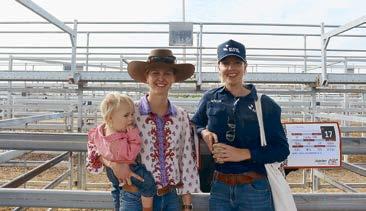




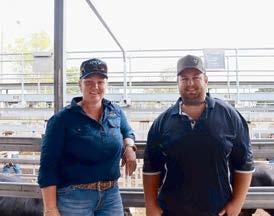

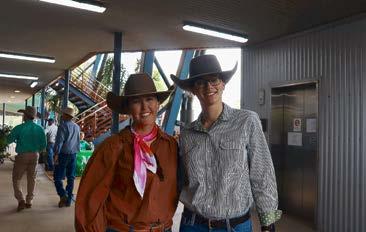



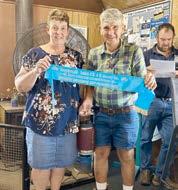

By Jane Lowe
The Goombungee-Haden AH and P Society held its annual carcase competition in October for vendor-bred cattle only.
The Hoof and Hook Competition calendar began on Saturday, 27 July when the cattle arrived at “Hesslands” Maclagan for their Induction process and Initial weigh-in.
All animals met the entry weight specifications of 180kg to 280kg.
The cattle were fed on a finishing mix for 80 days, at “Hesslands” 845 Bunya Mountains – Maclagan Road, Maclagan.
Weighing the cattle for the Best Weight Gain competition began on Saturday, 3 August.
The end of the feed period was on Saturday, 5 October at “Hesslands“ and a final weighing and judging of the Hoof competition commenced.
All carcases were AUSMEAT chiller assessed and MSA-graded.
Wednesday, 16 October saw the commencement of the slaughter date at Maclagan Meats and then on Saturday, 19 October vendors viewed the carcases at Maclagan Meats before lunch at Kulpi Hotel where prizes were awarded.
Event organisers say the event delivers an exceptional exhibitor experience and education for all vendors as they receive feedback on their animal/s performance.
The following prizes were awarded:
• Most Points gained with one beast in carcase and Hoof and Hook was awarded to Colin Shields, Everest Speckle Park with his Speckle Park Steer
Hook Competition
• Lightweight Carcase first place went to Col Shields, Everest Speckle Park with a Speckle Park Steer and second place to Gary and Janelle Schmaling (second year running) with an Angus Steer


• MSA Eating Quality Award went to Gary and Janelle Schmaling with an Angus Steer
• Best Weight Gain was awarded to Everest Speckle Park - Speckle Park Steer
• Largest Eye Muscle area went to Jordan and Rosie Minniecon - Charolais x Brangus
• Butchers Choice - Bruce Wieck, Wieck Pastoral - Limousin X Angus/Frieson - Judges special mention was made to Stephen Hartwig & WK Motley as all three beasts were very close
• Highest Dressing Out Percentage - Bruce Wieck of Wieck Pastoral - Limousin X Angus/Frieson Hoof Competition
• Prizes for the Hoof Competition were not awarded to exhibitors whose carcases do not meet the grading criteria.
• Hoof Competition was won by Stephen Hartwig with a Limousin x Droughtmaster heifer second place was awarded to Jordan and Rosie Minniecon with their Charolais x Brangus Steer. Carcases that did not meet the below were disqualified and were not eligible for any carcasebased prizes:
• Carcase weight range 180.0kg – 280.0kg
• Carcase P8 fat less than 5mm
• Carcase subcutaneous rib fat less than 3mm
• Carcase ultimate pH greater than 5.70


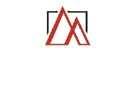




Bio-Boost Cal/Mag is specially formulated for low Calcium/ Magnesium soils to increase leaf size and productivity. Using a highly soluble source of calcium like Cal/Mag 5:1 can quickly remove harmful sodium salts from the root zone, establish valuable calcium, magnesium and nitrogen levels, provide proper nutrition for rapid recovery and vegetative regrowth. An excellent natural agent for fast pasture recovery.
Bio-Boost Foliage Spray is high in energy, with premium levels of Phosphorous, Nitrogen, Potassium and trace elements for good pasture or crop nutrition. Within seconds of application the spray starts to work systemically, helping to correct deficiencies and improve the health of pasture. Reduces the need for supplements, helps with weight gain and productivity.
Bio-Boost Foliage Spray travels right to the roots to compensate soil 'lock-up' and deficiencies in pasture and crops. Call 1800 809 229 for more






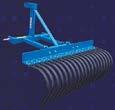
















Email: advancedfarmsystems@gmail.com



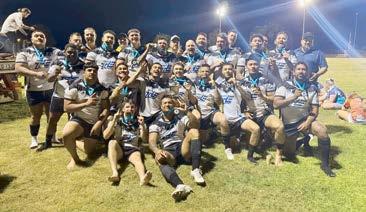
By Breanna Lloyd
Mining organisations across the Bowen Basin took their long-ignited rivalries to the rugby fields to participate in the 10th annual Clermont Battle of the Mines competition.
Held on Saturday, 5 October, the event hosted over 1000 attendees who came to watch 16 men’s and six women’s teams compete against each other for the 2024 championship title.
Amongst the footy frenzy were fundraising campaigns to raise funds for the CQ Rescue Helicopter service.
After battling each team throughout the day, the CMJV Turner Typhoons men’s team and the women’s Middlemount Machines (Dumpies) came out on top, claiming this year’s champion title.
Clermont Open Cut supervisor and event organiser Justin Barrett said the event is not just about rugby league.
“This event isn’t just about rugby league, it’s about celebrating strength, resilience and comradery that defines our mining communities,” he said.




enal,” he said.
“The support from each team manager has been tremendous every year and I hope it continues throughout the years.
“Once people see the event and understand the benefits of the day, they always line up to bring their team back the following year.”
Having played in the Clermont Hunters for over 10 years and in his ninth year of coaching senior rugby league, Justin said the sport is his strong passion.
“This event has done wonders for the mining community and it will be interesting to see what next year will bring,” he said.
“A big thank you to the sponsors who have come on board to keep this event running, without them, we wouldn’t have this terrific event.”
List of men’s and women’s teams who participated:
• Clermont Hunters
• Kestrel Rhino’s
• Hail Creek Storm
• BMA Peak and Proud
• Rolleston Roo’s
• Caval Ridge Crushers


“Just as our players work together on the field, we all work together in our everyday lives, supporting one another through life’s challenges and triumphs alike.
“This event is also about promoting and supporting mental health awareness.”
After accommodating several new teams who participated in this year’s event, Justin believes the event is shaping up to be a must-see occasion for the mining community.
“The teams are getting bigger and better every year and the team spirit it’s creating is phenom-

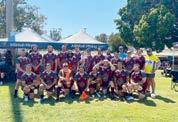
• Remember the Titans
• Grovenor Goats
• CMJV Turner Typhoons
• G Fab Gougers
• Orica Blue Sparks
• Jellinbah Cockatoo’s
• Fitzroy Ironbark
• ABM Aunty’s
• Middlemount Machines (Dumpies)
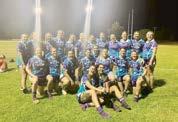
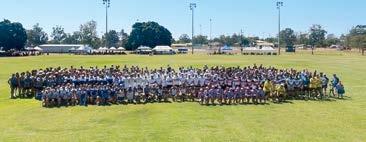
Prep time: 15 minutes
Serves: 4 people
Ingredients:
· 4 eggs
· 4 large croissants
· 1/2 cup crème fraiche
· 1 tbsp chopped chives, plus extra to serve
· 1/2 lemon, grated zest and 2 tsp of juice
· 1 cup watercress
· 100g smoked ocean trout slices
· Lemon wedges, to serve
Method:
1. Heat oil in a large non-stick frying pan on medium high. Crack eggs one at a time into hot pan. Cook for 2 minutes, until whites set and are crispy around the edges.
2. Split croissants in half and place cut side up on an oven tray lined with baking paper. Cook under grill for 30 seconds to 1 minute, until toasted and golden.
3. In a small bowl, combine crème fraiche, chives, lemon zest and juice. Season with salt and pepper and mix well.
4. Spread bases with crème fraiche mixture. Top with watercress, folds of trout slices and then a fried egg. Scatter with extra chives and pepper. Serve with lemon wedges and any extra crème fraiche mixture.
Recipe courtesy of Australian Eggs

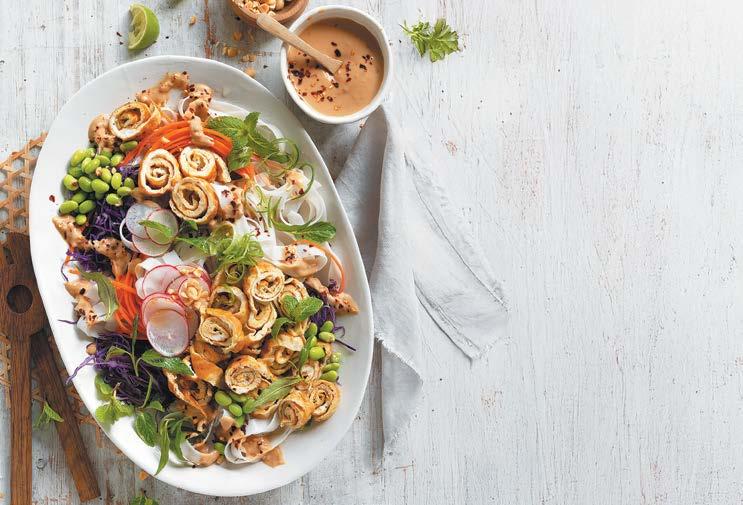
Prep time: 30 mins
Ingredients:
Peanut Sauce
· 3/4 cup (200g) crunchy peanut butter
· 1 clove garlic, crushed
· 1 tablespoon light soy sauce
· 1 tablespoon lime juice
· 4 tablespoons boiling water
Noodle Salad
· 6 eggs
· Dried chilli flakes (optional)
Method:
PEANUT SAUCE
1. Slowly whisk together peanut butter, garlic, soy and lime juice. Whisk in boiling water until it comes together into a smooth sauce. Set aside.
NOODLE SALAD
1. Whisk egg, chilli flakes and sesame oil together.
2. Heat half the vegetable oil in a frying pan over medium-high heat and pour in half the eggs. Swirl the pan to spread eggs evenly and cook for 1-2 minutes, until the eggs have set and the centre is still soft. Transfer to a plate to cool. Repeat with remaining oil and eggs to make 2 omelettes. Roll up and slice into 1cm thick ribbons.
Recipe courtesy of Australian Eggs
· 2 teaspoons sesame oil
· 1 tablespoon vegetable oil
· 200g dried flat rice noodles
· 2 cups (160g) shredded red cabbage
· 1 carrot, finely shredded
· 4-6 radishes, thinly sliced
· 4 green onions, finely shredded
· 1/2 cup (85g) edamame
· 1/2 cup chopped fresh herbs such as coriander, mint and Vietnamese mint
· Roasted peanuts to serve
3. Meanwhile, soak noodles in boiling water for 5 minutes. Drain and refresh with cold water. Drain well and add to a salad bowl along with remaining ingredients. Top with egg omelette ribbons, drizzle with peanut sauce, sprinkle with herbs and roasted peanuts. Serve immediately.
Tips:
· If the oil is separating from the sauce (this can happen from the oil in the peanut butter, but it’s easy to fix!), add a few drops of water at a time and whisk until it comes back together.
· For a quicker salad, toss a bag of shredded salad mix from the supermarket with the rice noodles, green onions and edamame.

Cattle Physical Report
Report Date: 17/10/2024
Saleyard: Blackall
2,700 head of cattle were yarded for the Blackall Prime sale this week. Cattle were drawn from the local supply area alongside one consignment from the Northern Territory. Overall quality of prime cattle was good with all the usual exporters present and active, while quality was mixed across the yearling pens.
A large line of vendor bred store steers met good support from local restockers with steers 280 to 330kg selling to 392.2c to average 365c, while heavy feeder steers over 400kg sold to 342.2c averaging 326c/kg.
Heifers lost ground this week mainly due to quality with heifers 280 to 330kg making to 252.2c to average 232c and medium weight heifers selling to 278.2c to average 262c/kg.
Grown steers to the processor sold to 312.2c to average 293c and heavy heifers made to 280.2c/ kg. Medium weight cows topped at 234.2c to average 220c and good heavy cows over 520kg were still pushed along by southern processors selling to 256.2c to average 236c/kg. Heavy bulls made to 242.2c to average 215c/kg.
Sam Hart, Market reporter
Report Date: 16/10/2024
Saleyard: Casino
Young cattle numbers are starting to decline with not the numbers of previous weeks however, there was a good yarding of cows. The yarding of young cattle consisted mainly of weaners with a small percentage of yearling’s offered. Quality of the weaner cattle was very plain, with only a few pens of young cattle showing freshness.
The market remained strong with restocker weaner steers selling firm to slightly dearer. Most steers sold from 274c to 432c to average 370c to 378c/kg. Restocker weaner heifers saw little change ranging from 230c to 296c/kg. Yearling steers to background sold from 270c to 360c and yearling heifers toped at 276c/kg.
The yarding of export cattle consisted mainly of cows, with insufficient numbers of grown steers for a quote, while the few grown heifers sold to 268c/kg. There was an improved quality yarding of cows yarded this week , however two buyers did not operate, resulting in a cheaper market, with heavy cows selling up to 20c cheaper, however medium and light cows were less affected. Medium weight 2 score cows sold from 204c to 241c while 3 scores averaged 252c and heavy 4 score cows sold from 261c to 273c/kg. There was a good run of restocker cows with the top pen selling for 306c/kg.
Report compiled by Doug Robson
Report Date: 23/10/2024
Saleyard: Dalby
There was a small lift of 200 head to 4,534 at Dalby. A fair panel of buyers was present and active across all grades. Prices for light weight yearling steers and heifers returning to the paddock experienced some small improvements. Light weight yearling steers averaged 4c better and the heifer

portion averaged 4c to15c/kg dearer. Yearling steers and heifers to feed received only minor quality related price changes. Heavy grown steers bullocks and cows experienced very little change in price.
Light weight yearling steers to restockers averaged from 386c to 392c with sales to 424c/kg. Yearling steers to feed for the domestic market averaged from 362c to 372c with sales to 393c/ kg. Heavy weight yearling steers to feed made to 380c average 355c/kg. Light weight yearling heifers returning to the paddock averaged from 280c to 287c with some to 320c/kg. Medium weight yearling heifers to feed averaged from 303c to 316c with some well bred lines to 348c/kg. Heavy weight yearling heifers to feed averaged 314c and made to 340c/kg.
Heavy grown steers and bullocks to export processors averaged 340c with sales to 351c/kg. Medium weight 2 score cows averaged 252c and made to 260c/kg. Heavy weight 3 score cows averaged 270c and the best of the heavy weights cows made to 286c to average 284c/kg. Heavy weight bulls made to 309c/kg.
Trevor Hess, Market Reporter
Report Date: 22/10/2024
Saleyard: Roma
Roma Agents penned 5758 head. All the regular processors feedlotters and backgrounders present. A mixed quality yarding of mostly western bred cattle. The market was firm to slightly dearer
for the lighter weight steers and heifers but cows lost ground by 5c to 10c/kg and more in places.
Light weight Yearling steers under 200kg topping 430c/kg. Yearling steers 200 to 280kg with the majority selling from 338c to 440c/kg. Yearling steers 280 to 330kg also improved and sold to 432c/kg. However Yearling steers 330 to 400kg lost ground and made from 280c to 388c/kg.Yearling steers 400 to 480kg gained a few cents and sold to 380c/kg. Yearling steers over 480kg made to 331c/ kg to processors.
Light weight yearling heifers under 200kg sold from 228c to 332c/kg. Yearling heifers 200 to 280kg with majority selling from 206c to 328c/ kg to restockers. Yearling heifers 280 to 330kg sold well to make 338c/kg. Yearling heifers 330 to 400kg could not maintain the levels and made to 338c/kg. Yearling heifers 400 to 480kg made to 326c/kg to feed. Yearling heifers over 480kg made to 316c/kg also to feed.
Grown steers 500 to 600kg with the majority making to 330c and selling from 294c/kg. Grown heifers over 540kg sold from 236c to 300c/kg. Another large number of cows were offered however could not maintain the levels of last sale. The majority of the cows were 2 score selling from 200c to 272c/kg. The 3 score cows topped 291c/kg. Bulls over 600kg sold to 293c/kg. Bulls 450 to 600kg sold to 278c with light bulls under 450kg making to 365c/kg.

Report Date: 22/10/2024
Saleyard: Warwick
Numbers remained unchanged at Warwick with 1,429 head penned. All the regular processors,wholesalers and feeder buyers attended and operated on a softer market for heavy feeder and restocker yearling cattle with quality being the main factor in any price variations however good heavy cows sold to dearer trends with bullocks firm.
Yearling steers 200-280kg to restockers sold to 398c and averaged 347c/kg. Yearling steers over 280kg to background made 386c/kg. Yearling steers to feed for the domestic market made 388c to average 340c/kg. Heavy yearling steers to feed sold to 360c and averaged from 337c to 343c/kg. Plain lines of yearling heifers in the 200-280kg range to restockers sold to 245c and averaged 223c/kg. Yearling heifers over 280kg to feed sold to 296c/kg. Yearling heifers to feed for the domestic market made 362c to average 291c/kg. Heavy yearling heifers to feed made 310c to average 280c with those to the wholesale meat trade topping at 386c/kg.
Bullocks over 600kg to processors made 347c to average 322c/kg. Full mouth bullocks averaged 295c and sold to 314c/kg. Grown heifers to processors made 320c to average 301c/kg. Light weight plain cows to processors made 251c to average 208c/kg. Heavy score 3 cows to processors made 270c to average 264c with good heavy cows gaining 3c /kg selling to 290c and averaging 275c/ kg. Heavy bulls sold to dearer trends at 312c to average 287c/kg.
Errol Luck, Market Reporter
Sheep Physical Report Report Date: 23/10/2024
Saleyard: Warwick
The supply of stock at Warwick halved with 973 lambs and 680 grown sheep penned. The regular buying panel attended and operated. New season young lambs to the wholesale meat trade sold to dearer trends with the older lambs selling to firm prices depending on type and finish offered. The grown sheep generally sold to easier trends. Very light weight young lambs to restockers sold from $60 to $64/head. Young lambs over 12kg to restockers sold from$90 to $104/head. New season lambs in the 18-20kg range to the wholesale meat trade sold from $120 to $148 with those over 20kg at $159 to $180/head. New season heavy lambs topped at $202/head. Older lambs in the 18-20kg range to feeder buyers sold from $114 to $149/head. Trade weight older lambs sold from $134 to $205 with the heavy lambs to processors topping at $237/head.
Dorper hoggets to processors sold from $110 to $139 with the crossbred hoggets at $124 to $160/head. Light weight ewes to processors sold from $26 to $54 with the heavy ewes to processors at $71 to $97/head. Merino wethers to restockers sold to $70 with wethers to processors at $82 to $84/head. Ram lambs to the wholesale meat trade sold from $117 to $150/head. Older rams to processors sold from $60 to $110/head.
David Friend, Market Reporter
Errol Luck, Market Reporter
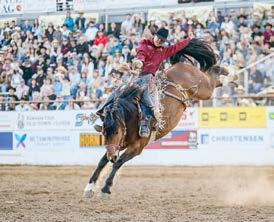
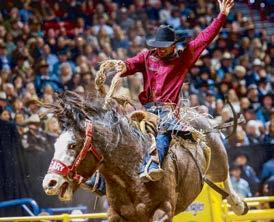

By Breanna Lloyd
Queensland-born and bred bronc riding superstar and current world champion, Damian Brennan, is gearing up for a nation-first event, the Cinch Australian Open International Bronc Match on Saturday 2 November at Scone, New South Wales.
Damian will be up against top shelve talent from international competitors from the USA and Canada including Dawson Hay, Kade Bruno, Riggin Smith and Logan Hay.
A whopping prize of $50,000 is up for grabs for first place.
Damian said he is ‘pumped’ for the event and can’t wait until it kicks off.
“It’s a big event for bronc riders, and there’s always a lot of talent competing,” he said.
“It will be interesting to see how the event plays out.”
Damian grew up in rural Queensland where his life revolved around horses and livestock.
Before delving into his outstanding bronc riding career, Damian worked on his family property, where he learned how to handle horses.
Not long after high school, Damian ventured to the USA on a full scholarship with Snyder College in Texas.
Since completing his scholarship, Damian has been named a ‘rockstar’, as he brings the authentic spirit of the Australian Outback to rodeo circuits internationally.
Recently Damian returned from a recordbreaking season in the USA with career earnings surpassing $389,000.
Now in his eighth year of bronc riding, Damian believes he will continue galloping through his passionate career, along with his fellow bronc riders.
“I love the sport too much to walk away anytime soon,” he said.
“As long as my body holds up and I’m still hungry for it, I’ll keep riding.
“What I enjoy the most is the adrenaline. I also



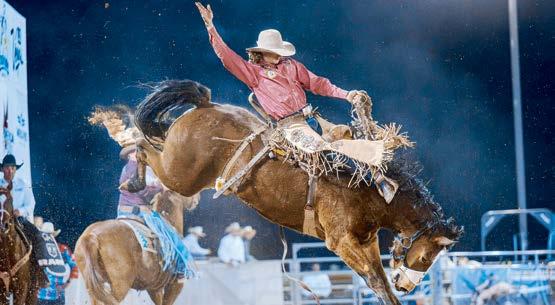
love the camaraderie with other riders—we’re all competing, but there’s a brotherhood among us.”
Damian said he is grateful for all of the support he’s had along the way.
“Special thank you to my fiancee, family, friends, and sponsors,” he said.
“It’s been a wild ride, and I’m excited for what’s still to come.
“Bronc riding has taken me places I never thought I’d go, and I’m looking forward to pushing my limits even further.”


Learn about the international bronc riders: Riggin Smith:
With career earnings of $162,838, Smith’s personality is infectious and hilarious making him a standout to interview.
Winner of the American Royal Rodeo and the Clark County Fair and Rodeo in 2024, he was also crowned the 2019 College National Finals Rodeo Saddle Bronc Riding Champion.
Kade Bruno:
Ranked third in the world, Bruno has made a name for himself with $545,000 in career earn-
ings and is recognised globally for his charisma and competitive edge.
Dawson Hay:
With over $844,000 in career earnings, Hay is a four-time Wrangler NFR qualifier known for his consistent performance and significant wins across North America.
Logan Hay:
Known for his engaging and comedic personality, Logan brings a captivating presence to the arena, making him a favourite among fans as he appears alongside his brother, Dawson Hay.
